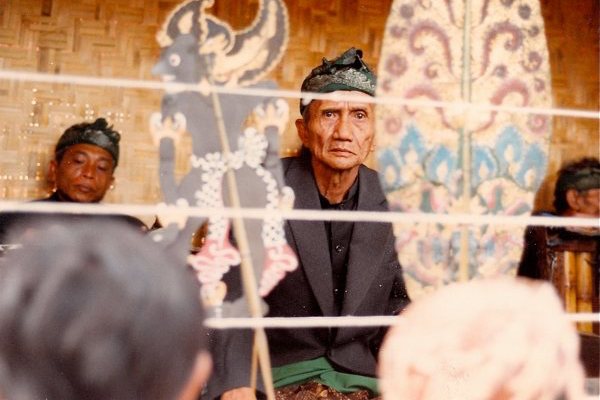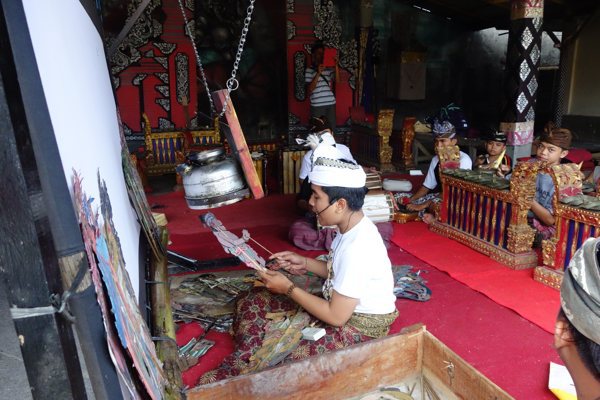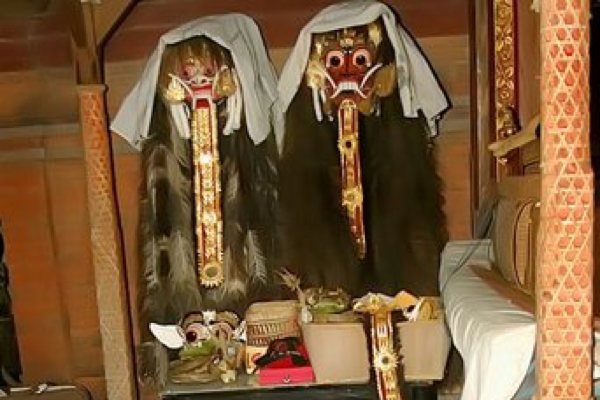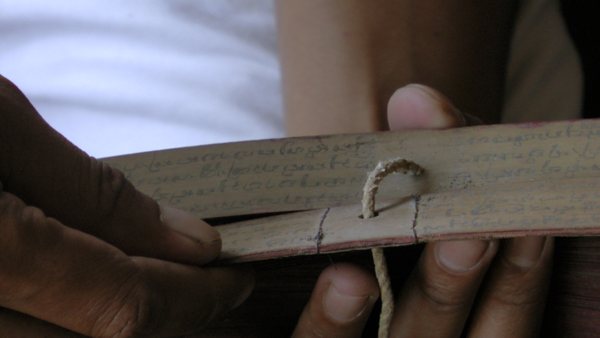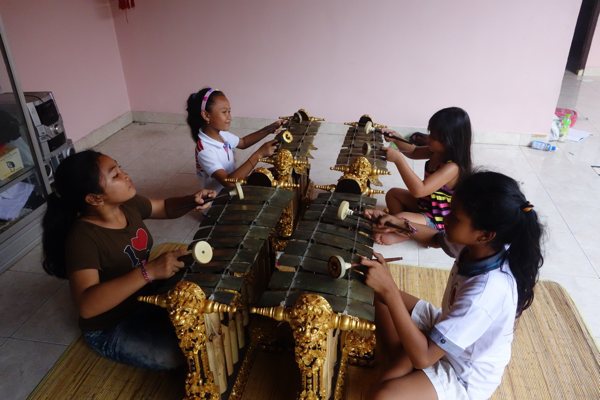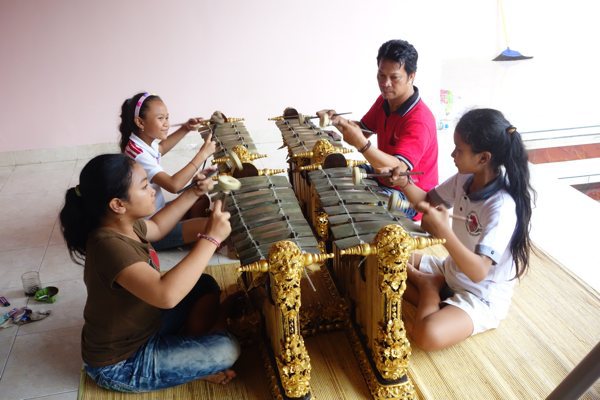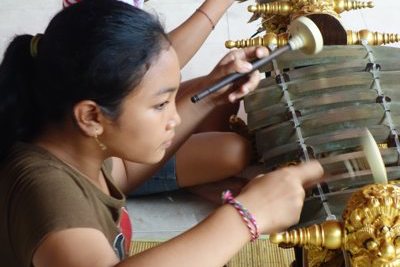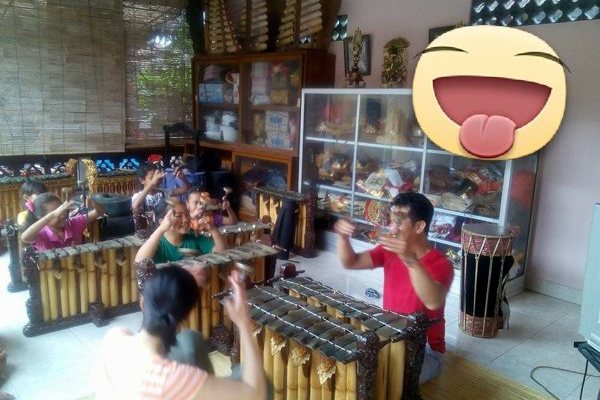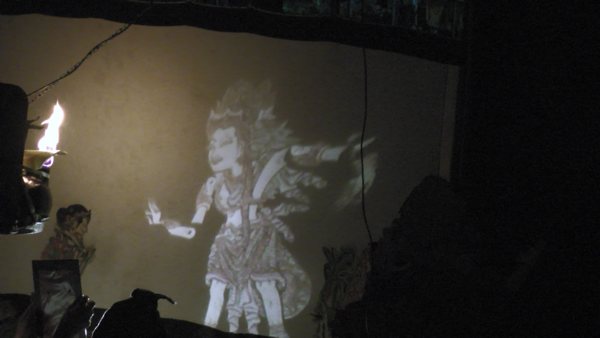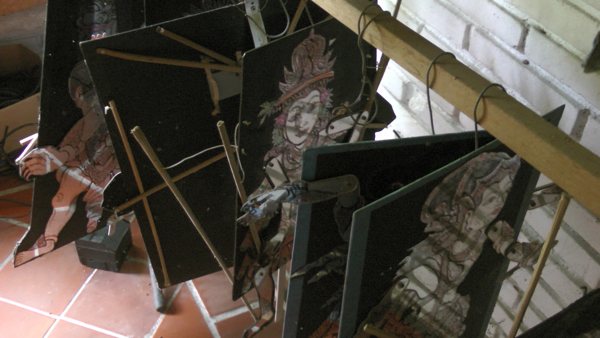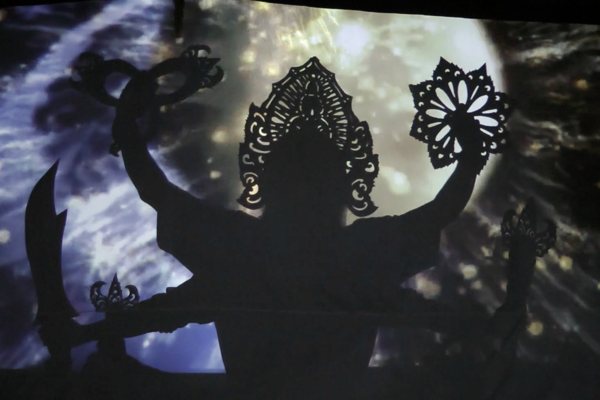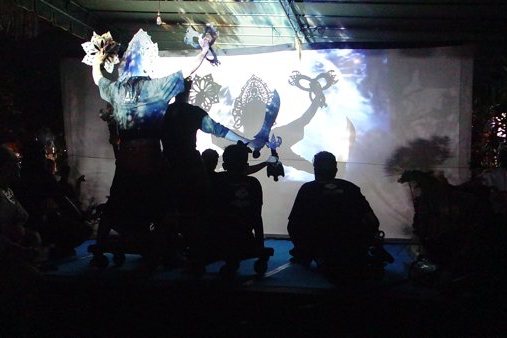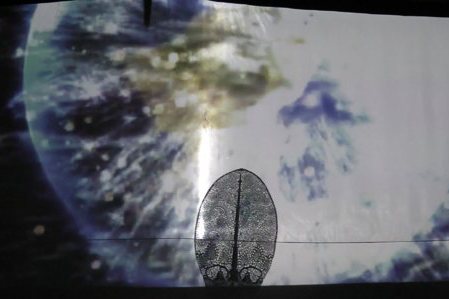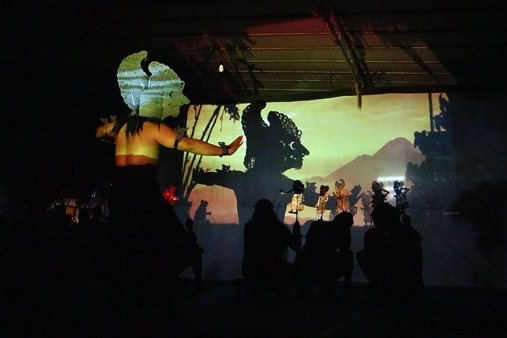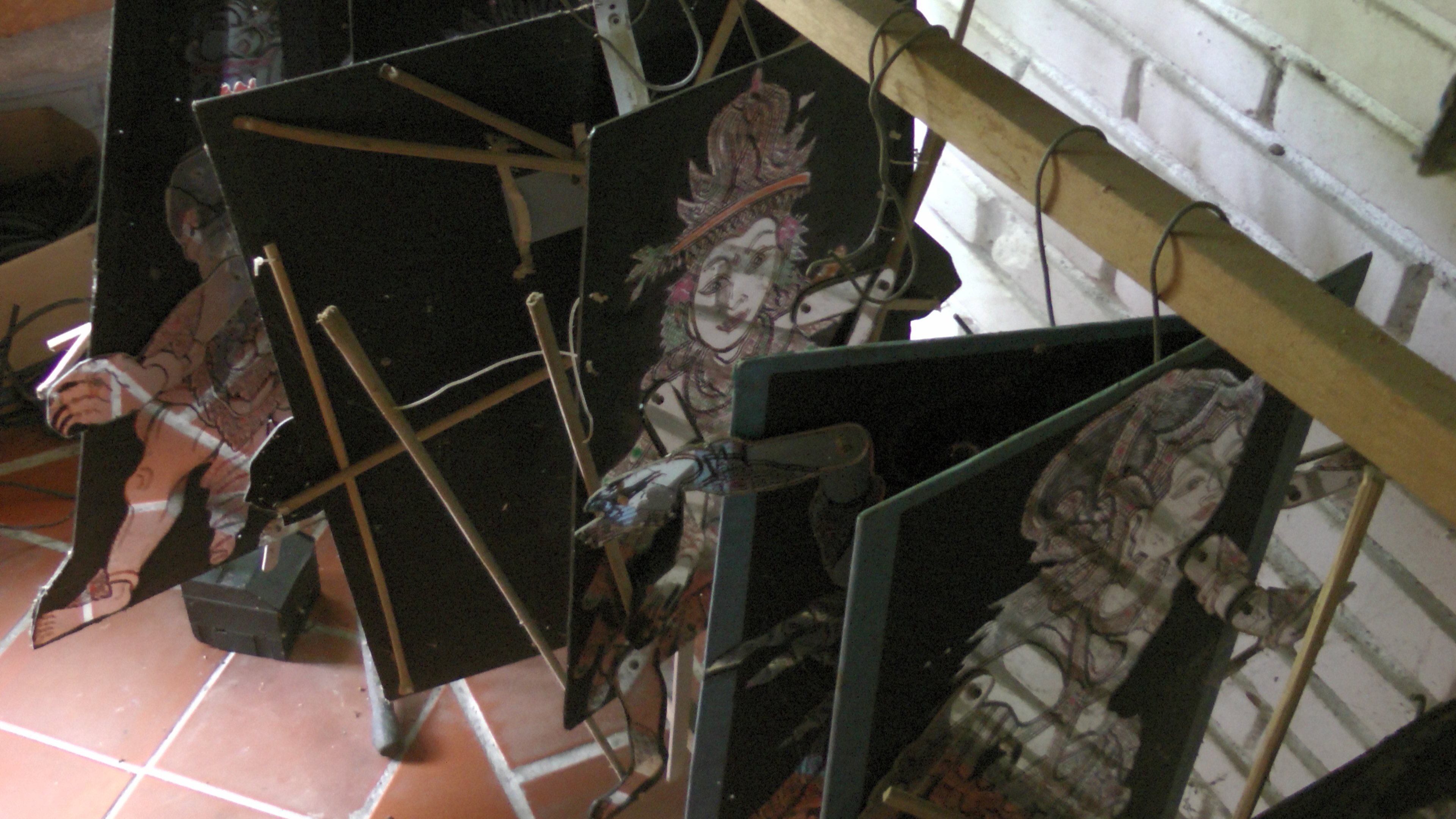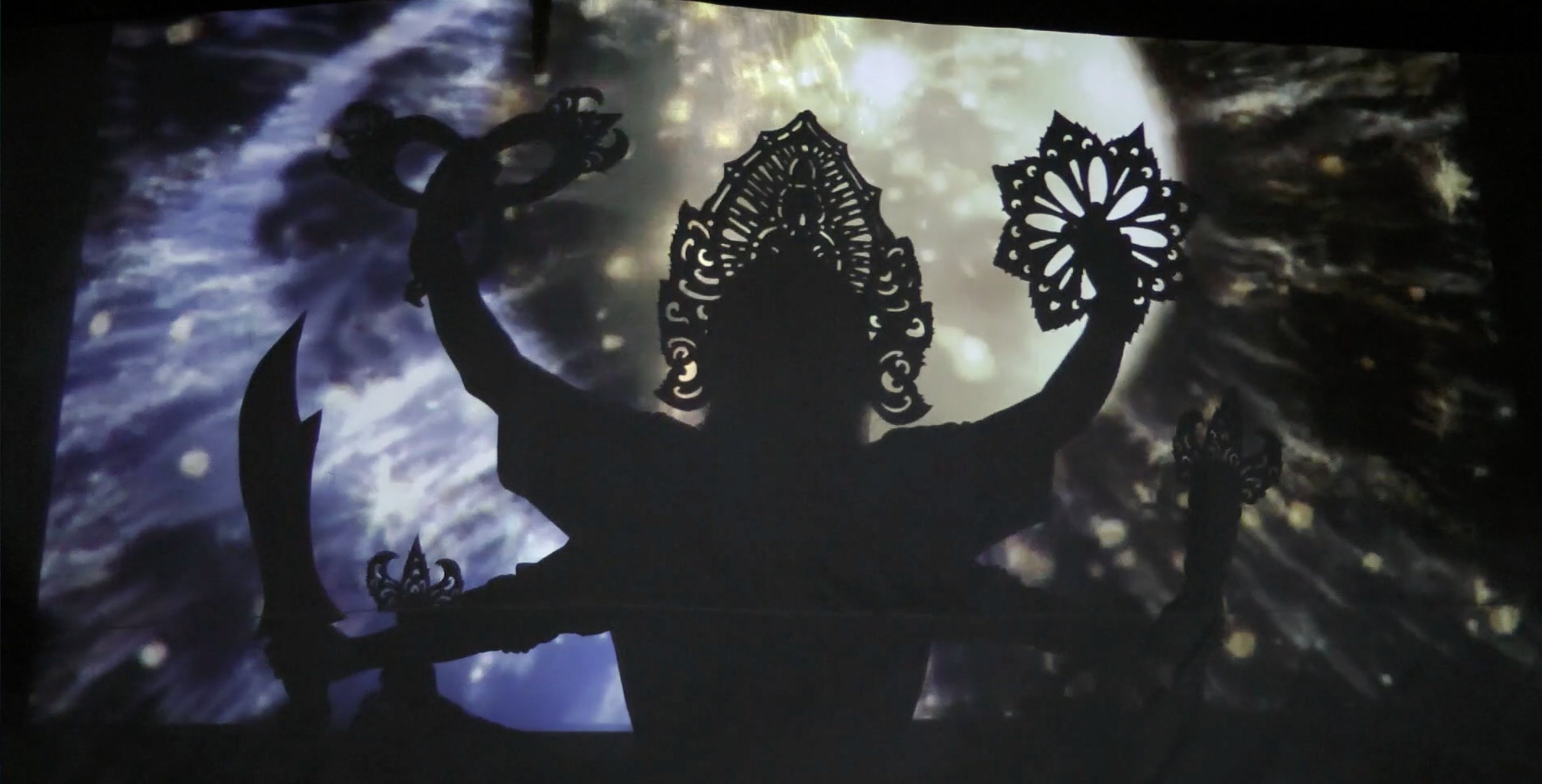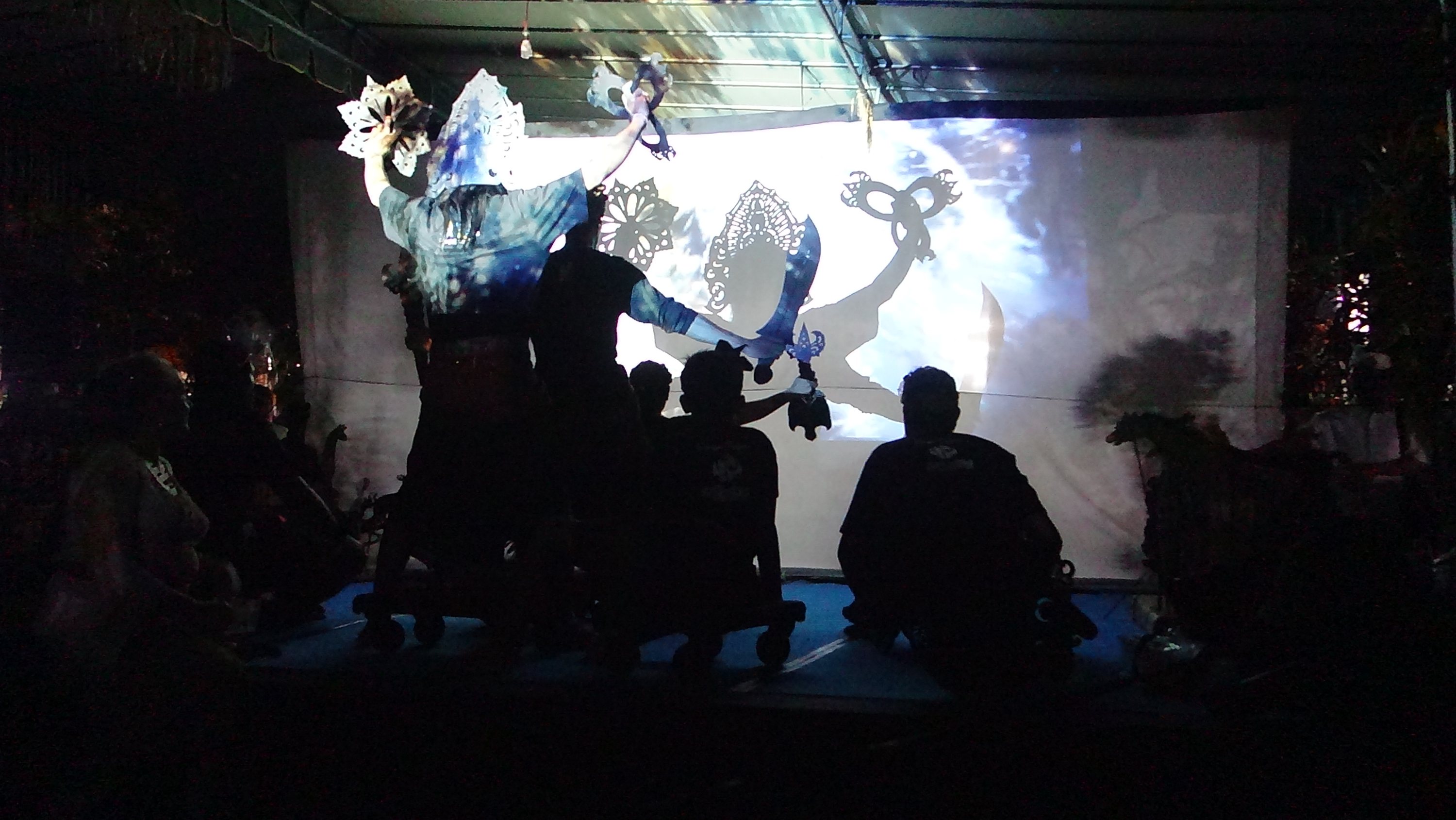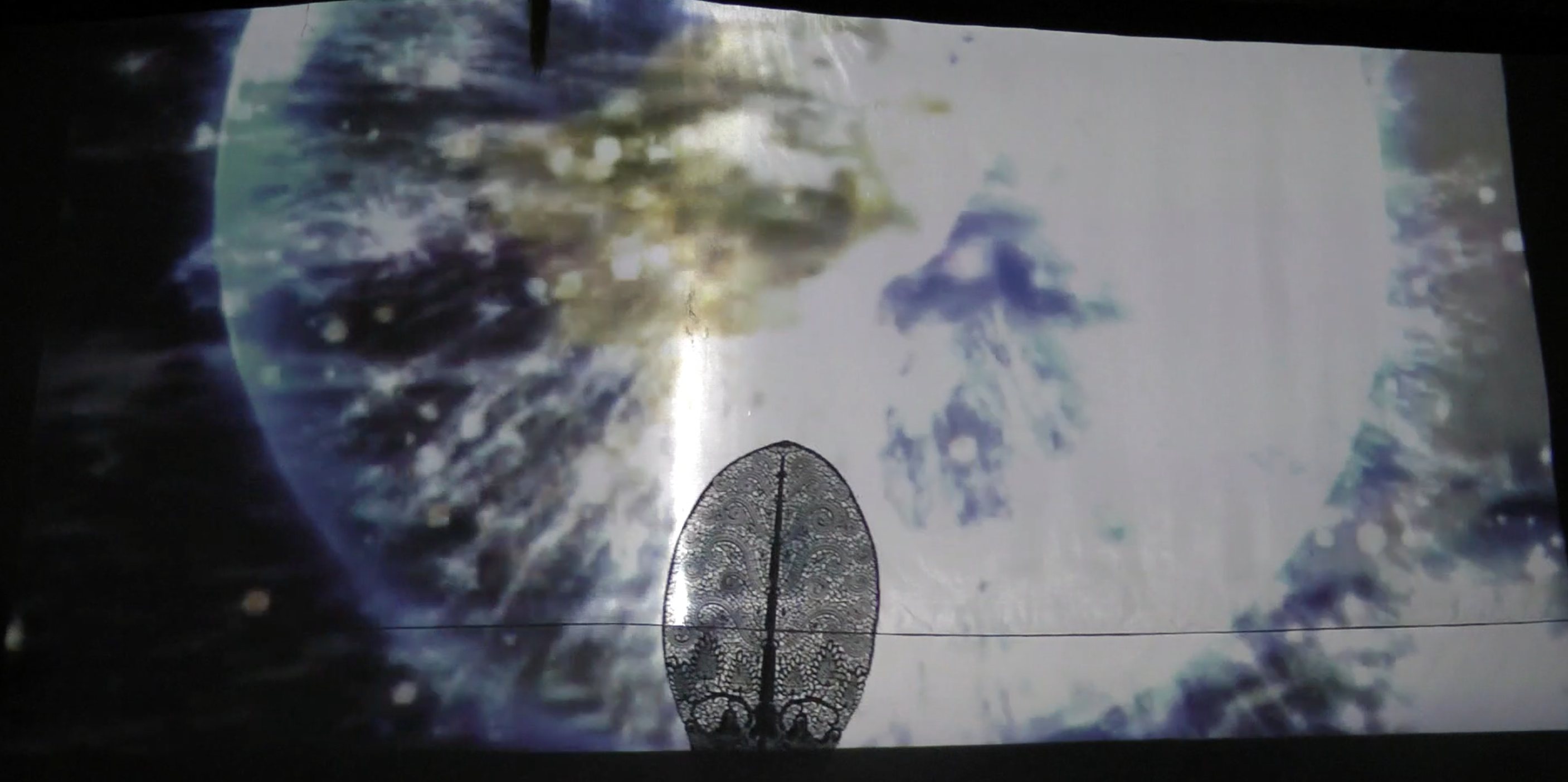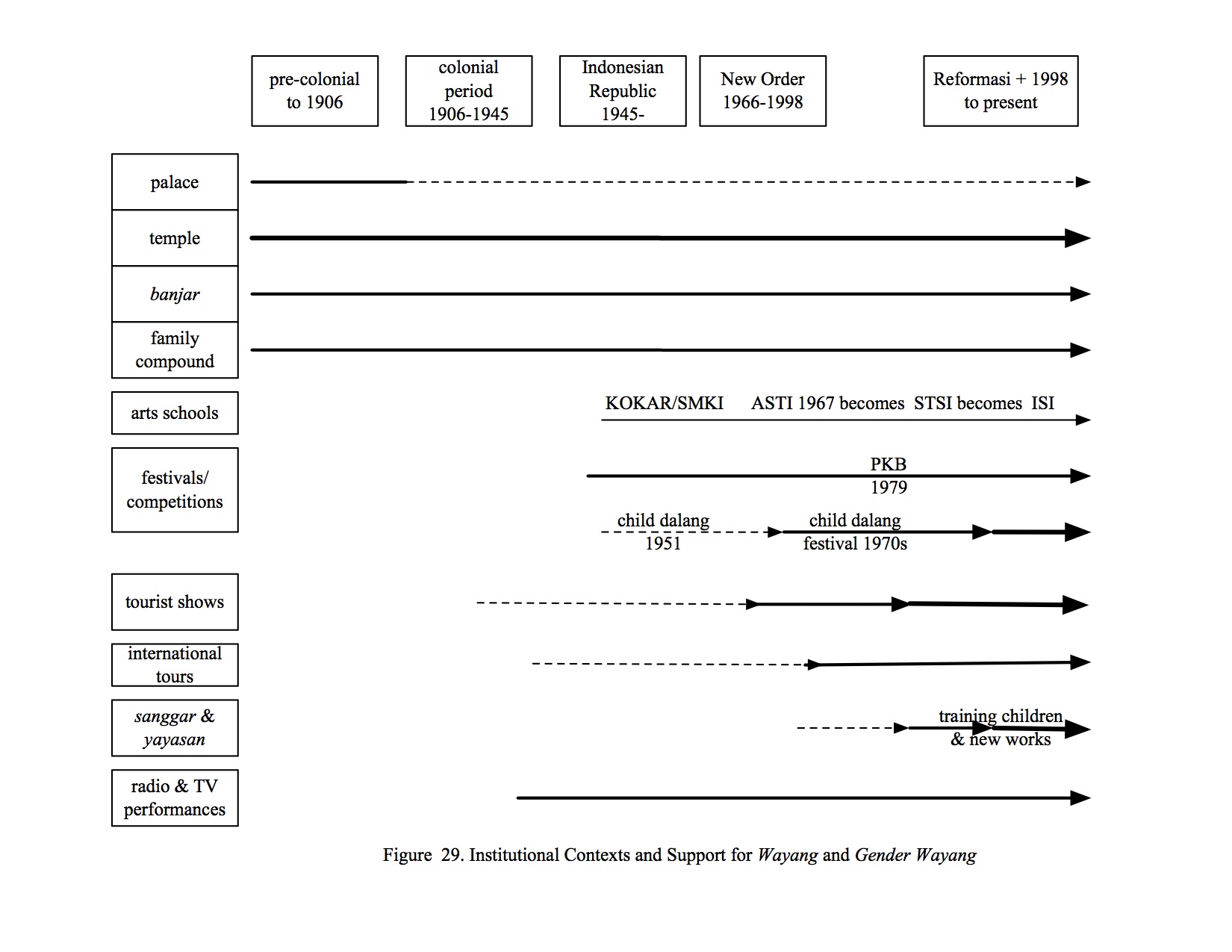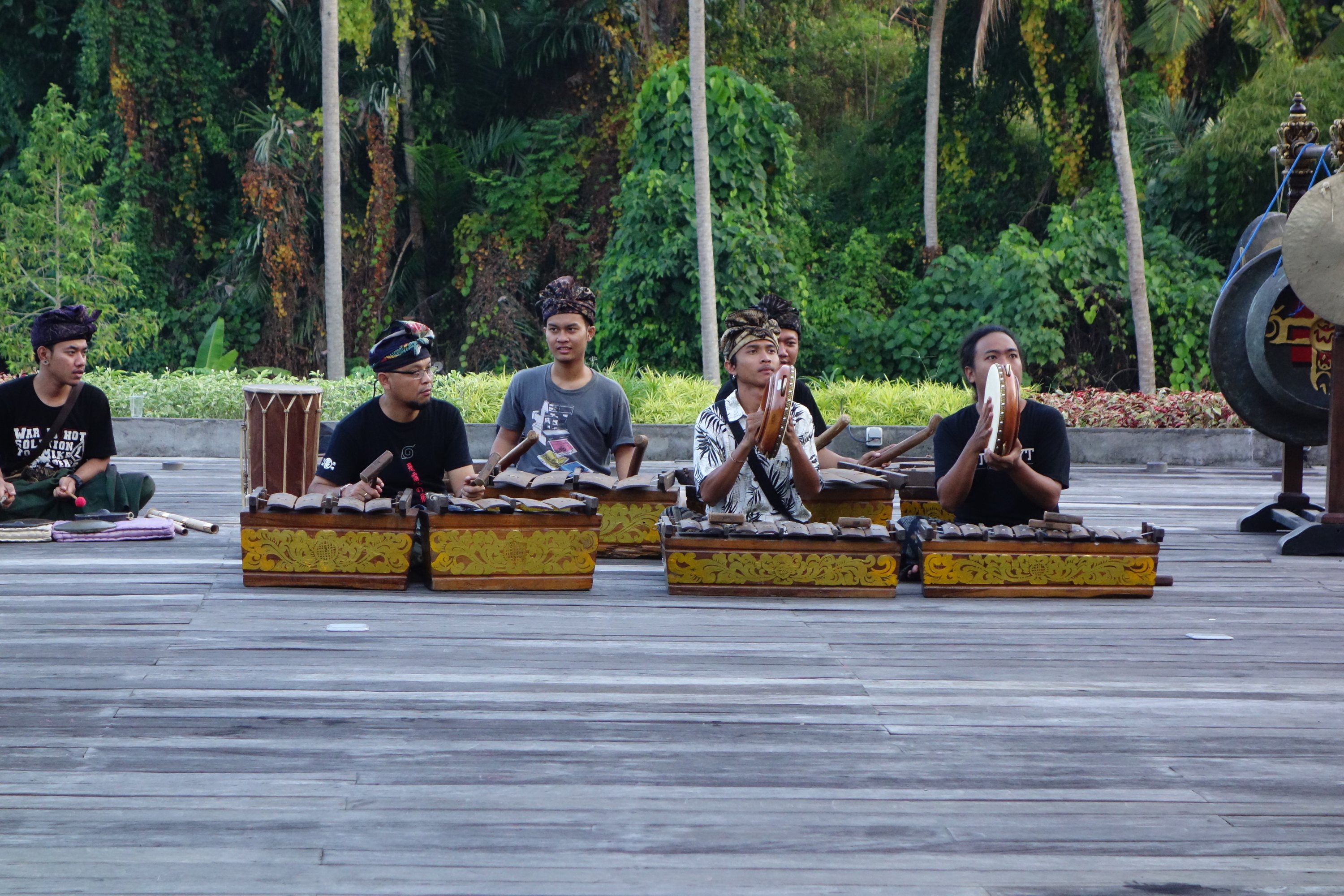Musical Knowledge, Innovation, and Transmission Within the Ecosystem of Balinese Wayang Performance
By Lisa Gold
Abstract
This chapter looks at change and recent developments in Balinese wayang, musical transmission, and performance practice across several generations, from zaman dulu (the bygone past, as remembered by my elderly teachers in the 1980s and 1990s) to the present, and from “traditional” to “electric wayang.” I discuss the burgeoning contemporary performance scene and the transmission of musical knowledge in terms of a performance ecosystem, and I explore changes in performers’ perspectives, mental mapping of repertoire, performance opportunities, and performance practice. I have closely followed the performance lives of several key players in the gender wayang and wayang transmission of South Bali since 1981, and I continue to follow innovations and changes associated with the younger generation of players and cross-cultural influences and collaborations. The concept of performance ecosystem is at the center of an ongoing project that I have been developing, with case studies in Bali, Java (along with Ben Brinner), and beyond.
Innovation and Transmission
On recent research trips to Bali, I met with some of the key players in the wayang kulit (shadow puppet) performance scene today (musicians and dalang, shadow masters). Foremost on all of their minds was transmission and their role as transmitters of knowledge from their teachers, who remembered a more complete and rich tradition from what they termed zaman dulu (a bygone past or an earlier era), to the younger generation. As descendants and recipients of this knowledge, they are aware that they hold the keys to the perpetuation of Balinese wayang (shadow puppetry), its music, and the constellation of knowledge within and surrounding it.1 None knew that was precisely what I was there to discuss with them. They brought it up independently as a passionate preoccupation: How to ensure that this tradition will continue in the face of today’s many challenges? Many important related issues arose. While they debated as to the best ways to go about this, all acknowledged that built into Balinese “tradition” is innovation. When they spoke of the relationship between shadow master and musicians, or among gender wayang musicians, the performances that they considered to be true to past practices all have an improvisational, or flexible, component to some degree. That said, the concept of “traditional” Balinese performance still differs, often drastically, from contemporary performances, whose advancements push beyond the boundaries of longstanding innovative practices. I will therefore use the terms “traditional” and “innovative” to denote these distinctions. Both tradition and innovation are lively organisms that play off of one another. This paper shares some perspectives from these influential leaders in their fields.2 I begin with a brief history of an individual gender wayang composition (Merak Ngelo) that demonstrates ways a single piece can acquire meaning and move from one person to the next, even internationally. I then briefly discuss the relationship between individual performers from three stylistic areas that are historically linked. The remainder of the article examines changes in transmission methodology, pedagogy, and the way people learn this repertoire today and ultimately impact the very content of the material transmitted. The necessity to innovate in order to draw in the youth and hence perpetuate tradition lies at the heart of the discourse for all of the performers with whom I worked. Their views, however, on the best ways to go about maintaining the depth and meaning of this tradition vary.
Television and Gender Transmission
Televisi Republik Indonesia (TVRI), the government-run television station, begins its programming each day with visual scenes of some of the most important temples in Bali—Besakih, Tanah Lot, and Pura Ulun Danu Beratan—as a Brahman priest recites the Trisandya invocation in the Sanskrit language.3 This segment is broadcast three times each day.4 Accompanying the invocation is the piece Merak Ngelo played on the gender wayang ensemble (a quartet of metallophones). Roughly translated, the text in the Indonesian subtitles reads, “Gather together and cleanse thoughts before praying.”5 When the Trisandya is invoked during temple festivals (odalan), it is often sung by a priest without musical accompaniment, but it is usually heard throughout the temple and its environs through distorted loudspeakers as people pray.6 Through this daily televised ritual, the sacredness of Balinese culture is reaffirmed, followed by a plethora of foreign and secular programming. The music of gender wayang is particularly expressive of the sacred in Balinese life. It is played in important rites of passage as well as at accompanying wayang kulit (shadow puppet theater), so it is fitting that gender wayang should be used for this televised ritual as well, even if the choice of music was more the result of chance events than original intention.
One of the gender musicians playing the piece was I Wayan Konolan (1931–2008) from Banjar Kayu Mas, Denpasar. Upon learning the piece, Konolan taught it to the gender group at the Indonesian radio station RRI (Radio Republik Indonesia), where he worked.7 These musicians played for TVRI as well. When I asked Konolan why he chose that piece for this occasion, he explained the process to me. When they rehearsed at the television station, he suggested they play the gineman Trisandya (an extended, introductory section) preceding Merak Ngelo, which may precede other pieces, particularly to accompany praying. Due to time constraints, the TV station director told him to skip the gineman and play only the pangawak (slow, “main body” of a piece) of Merak Ngelo instead. This piece became an emblem of Balinese religion and culture as it accompanies the Trisandya each day.
The way that Konolan learned this piece was serendipitous. He was introduced to this version of Merak Ngelo by his son, I Wayan Suweca, who learned it in the United States while he spent six years here teaching gamelan. John Badanes, the American who taught it to him, learned it from Andrew Toth, another American who learned it from I Nyoman Sumandhi, a shadow puppet master and scholar from the village of Tunjuk in the district of Tabanan, who also spent many years teaching and studying in the United States. According to Sumandhi, the last section of the piece (the pangecet) originates in the village of Mas in the district of Gianyar, and the whole piece originated from the well-known composer I Wayan Lotring8 from Kuta, who visited Tunjuk and spent time in the village of Sukawati, Gianyar, which had historical links to Tunjuk. Much later, the musician I Wayan Loceng (1933–2006) from Sukawati took the piece and altered it to suit his own idiosyncratic, complex style of playing.9
A recent addition to this story of Merak Ngelo and the Trisandya is now that the televised version of the Trisandya is broadcast through loudspeakers at most balé banjar (neighborhood community centers found in every village or town), one hears it even when driving past. One person commented that he believes this broadcasting of the Trisandya through speakers at specific times each day is perhaps influenced by the Islamic call to prayer that is heard throughout Java but rarely in many parts of Bali, other than Denpasar and certain villages with mosques (I Dewa Antara, driver and cultural guide, personal communication, April 2015). The soundscape of Bali thus has been dramatically altered. What was once a personal, internalized invocation restricted to Brahman priests has become standardized through the TV rendition that is imposed on the general public at regular intervals and then externalized.10
Another side story about the piece involves I Wayan Suweca, a gender wayang master from Kayu Mas and the son of Konolan, who brought the piece to TVRI. Suweca has recently declared the piece a gending wajib (required piece) for gender wayang competitions (Suweca, personal communication, April 2015), thus making it even more ubiquitous.
The transmission history of the piece Merak Ngelo, played in its many versions throughout the island of Bali, extends far beyond the narrative described above, as would the transmission of any piece in the gender repertoire. The associations that the pieces take on, hence their musical meaning, are flexible and changing, and are closely linked to time, place, and people.11
Time and place are experienced on multiple planes within the minds of Balinese performers as past and present, cyclicity and linearity, mythological, legendary, and modern, local, and global worlds conflate. In a constantly fluctuating ecology of performance scenes, people are confronted daily with new juxtapositions: global/local, new/old, high tech/low tech (cell phones and Facebook alongside coconut oil lamps and ancient stories). Scholars (especially those of the early twentieth century), tourists, and the media in general often view these juxtapositions as contradictions, but they are not necessarily at odds with one another. They work together to form the tension that has always been the driving force behind the creative process. New performance contexts emerge, different meanings are ascribed to sound and performance, and multiple connections between performers are forged in a cumulative process as older contexts simultaneously continue.
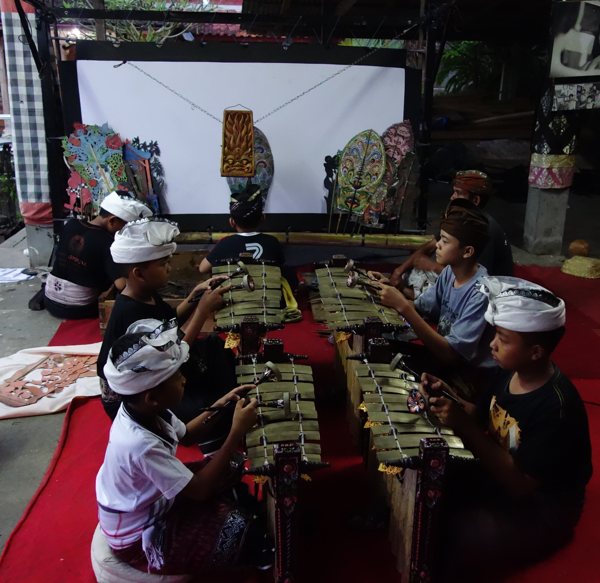
Here I focus on the performers of Balinese wayang: the dalang, a shadow master and spiritual practitioner, and an accompanying quartet of gender wayang musicians (fig. 1). Dalang and musicians experience wayang as a site for bringing together the past and present, for connecting place to place, and for recalling deeply personal teachings, repertoire and sonic techniques, and aural icons that are kinesthetically embedded in their minds and bodies.
Gender wayang is one of the smallest ensembles in Bali. A pair or quartet of musicians plays complementary parts, often featuring kotekan (interlocking figuration), stratified texture, lyrical melodies, and pieces with flexibly changing tempi. The lack of an audibly articulated gong structure allows for asymmetrical phrasing and musical gestures that are not common in the larger ensembles.12 This is considered an aesthetically refined and technically challenging ensemble that attracts a certain kind of individualistic, creative player and has generated much variation, elaboration, ingenuity, and creativity (video 1). Most of the top players prefer to play with the same group members. Each style is so idiosyncratic that they need to play together on a regular basis, even within broader stylistic areas. For example, I Gusti Nyoman Darta (a.k.a. I Gusti Komin) and his brother, I Gusti Ketut Muliawan, both innovative players on the forefront of gender wayang performance from the village of Pengosekan, have found it difficult to find others who can match their technical expertise and musical interpretation of the repertoire. They are constantly changing pieces to suit their creative sensibilities, to the point where few players are capable of playing them (video 2).
Video 1. I Ketut Buda Astra and I Komang Wraspatika playing the piece Sekar Ginotan on gamelan gender wayang (brief excerpt). Recorded by Lisa Gold and Ben Brinner in Banjar Babakan, Sukawati, in 2011; used with permission.
Video 2. I Gusti Nyoman Darta (a.k.a. I Gusti Komin) and his brother, I Gusti Ketut Muliawan, playing Composition no. 1, “Aptining Ngulun,” composed by Gusti Komin on gender wayang. Posted on YouTube by Tomoki Yonehana.
Another example is I Made Subandi from Batuyang, a neighborhood of the town of Batubulan. Subandi and his father, Pak Dig, have developed a unique playing style related to that of Sukawati, due to the proximity of the two towns as well as their interaction with Sukawati performers. Greatly influenced by and influencing most major styles in Bali, Subandi is considered one of Bali’s most proficient players and prolific composers. More than any other Balinese ensemble, gender wayang lends itself to vast degrees of interpretation and variation of pieces.13 Dalang have also developed this technical virtuosity and numerous experimental forms that diverge from tradition. Many of these require their own group of musicians who understand how to accompany new forms.
While the popularity of what I call “traditional” Balinese wayang is waning, people flock to contemporary performances meant for more secular entertainment. Yet many value wayang and consider it central to Balinese life. Beyond entertainment, wayang and its accompaniment are necessary components of many life-cycle rituals, temple ceremonies, and purification rites (Gold 1998).
An Ecological Approach
To help understand how it is that such robust musical and artistic change can continue to invigorate (and challenge) the wayang and gamelan scene today while ongoing traditions are maintained, I have suggested viewing a performance community as an ecosystem (explained further in Gold 2013 and Brinner 2004:3–4).14 The scope of this paper does not allow for a full exploration of the performance ecosystem, so I will only touch on a few points to suggest aspects that can be further developed elsewhere. Here I limit my discussion to changes in transmission, networks of players, and performance context niches, but the complete project includes looking at several interrelated factors. Within the ecological approach, we can characterize a set of relationships as a network. One crucial network is that of individual performers, innovators, creators, and guardians of tradition. Throughout the trajectory of wayang performance history, certain people stand out as “hubs,” connecting people and practices and serving as repositories of history and knowledge. As in ecology in the natural world, these people influence others and affect outcomes.
I use the term “niche” based loosely on the ecological concept of how an organism makes a living, what sustains or threatens its existence, and what differentiates it from those in other niches. The niche is affected by a number of factors, and it in turn alters those factors. James Gibson introduces a “theory of affordances” of the environment. “What it [affordance, Gibson’s reworking of the concept of niche] offers the animal, what it provides or furnishes, either for good or ill. The verb to afford is found in the dictionary, but the noun affordance is not. I have made it up. I mean by it something that refers to both the environment and the animal in a way that no existing term does. It implies the complementarity of the animal and the environment” (Gibson 1986:127). Gibson differentiates habitat from niche in that “a niche refers more to how an animal lives than to where it lives. I suggest that a niche is a set of affordances” (Gibson 1986:128). I have conveniently borrowed concepts of ecological modeling and extended them beyond their normal application to nature. Designating what is sustained and what is lost is not the sole aim of this approach, but it certainly plays a large role when analyzing the interactive performance ecosystem.15 A central aspect I consider involves networks of performers and ways that they interact, influence one another, or remain autonomous. I therefore view network theory as subsumed within the ecosystem, because a network highlights a particular set of relationships influencing the ecosystem.
The organisms of the performance ecosystem are the pieces themselves, bodies of repertoire, individual and regional playing styles, vocal repertoires, performance practice and dramatic concepts, such as scene unfolding and development, and shaping and timing of the play, among other elements. These are all affected by performance constraints and possibilities linked to niches, as well as by the performers who themselves are influenced by other performers, by audience demands and responses, by societal pressures and requirements, government mandates, and so forth, which are all impacted by the changing, now globalized Bali. Certain repertoires shrink, while others expand and take over preexisting ones; individual versions of pieces can do this as well, superceding others. As human agents, the focus of such a study must be the individuals who enact these changes.
Transmission Histories: Three Styles and Early Innovations
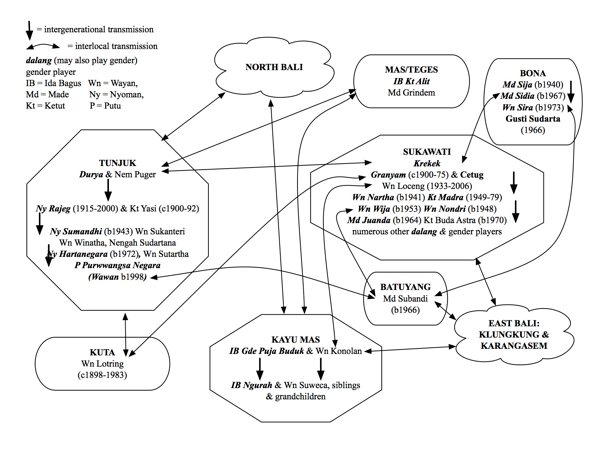
My work is based on three places within the larger performance ecosystem of southern Bali that represent contrasting regional traditions but share a repertoire of pieces and songs, are historically linked, and are central to the history of Balinese wayang, namely, Sukawati (Gianyar), Tunjuk (Tabanan), and Kayu Mas (in the capital city of Denpasar, Kodya, formerly Badung). Also figuring into this picture is transmission from Kuta, Karangasem, and North Bali. Some connections within and between each of these three stylistic lineages are evident (fig. 2). A more complete diagram that maps transmission links of all performers would look like a very dense circuit board.
Banjar Babakan, Sukawati
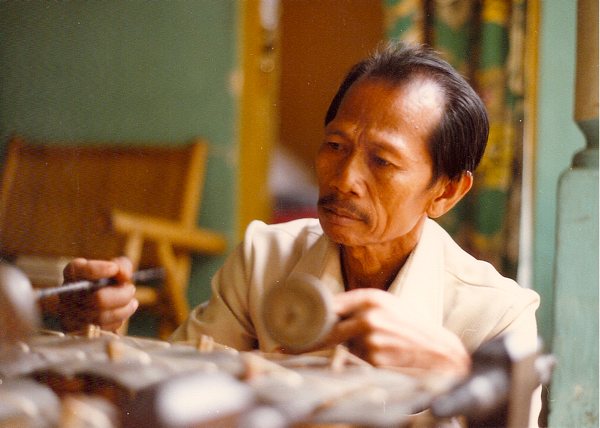
Individual gender players not only make their mark by changing pieces but also by what they remember. I Wayan Loceng from Sukawati was a pioneer in this regard (fig. 3). His neighborhood, Banjar Babakan, a historic wayang center, has a high concentration of wayang performers, and much of the tradition there is passed through extended family ties. The old pathways of life in this banjar were immersed in wayang. During my first visit to Bali in 1981, sounds of gender wayang and singing wafted between houses and the road. Everyone knew what everyone else was doing artistically and otherwise.
Now that the road is paved, and traffic has been rerouted right through the center of Banjar Babakan, the sounds of wayang activity still going on behind walls is drowned out. Yet, despite a great change in the built environment and the quality of life, it remains a vibrant, highly competitive, and innovative wayang scene that dominates the South Bali performance ecosystem, displacing many other local gender styles and extending to influential musical centers, such as Pindha and Pengosekan.16
While Loceng was one of the few players to retain the older versions of pieces, he was also one of the most innovative performers in his time. Many younger dalang trained under Loceng, yet he was reticent to share his versions of gender wayang pieces with other musicians. He personally felt that his versions of pieces were an intrinsic part of him, much like a beloved family member. With the constant fear that other musicians would “steal” his versions, Loceng would “hide the music within the music” (Loceng, personal communication, numerous times since 1982). He made it so nuanced that other players found it difficult to pick up just by hearing it. He often accomplished this by omitting notes, thus rendering the piece more abstract, by inserting ngoret (grace notes executed by combining sliding and bouncing the mallets from one key to another), by adding technical challenges few could master, such as double-damping, which he called tetekanan (pressure),17 and by making more convoluted, rapid, syncopated kotekan. In the network of gender wayang players involved in transmission and composition, Loceng was central: he was both a “hub” and a mediator linking his generation with zaman dulu. (See Brinner 2009 for more on networks.)
While Loceng’s gender wayang style had its unique qualities, the broader Sukawati gender style (of which Loceng’s was a variant) is shared among many players in Banjar Babakan. Some notable talented younger players today are I Ketut Buda Astra, who is known for his innovations, playing style, and activities in numerous projects that perpetuate the arts in his area; Loceng’s son, I Ketut Sukayana; and the sons of the female dalang Ni Wayan Nondri and the late renowned (male) dalang I Ketut Madra.18 The dalang I Wayan Nartha performed extensively with Loceng and continues to perform today, as does his son, I Ketut Sudiana, although mainly for daytime ceremonial performances.
The central figure in zaman dulu, for Loceng and virtually every other performer with whom I worked (including, less directly, those from other stylistic areas), was the dalang I Nyoman Granyam (circa 1900–1975). Granyam made many significant contributions to wayang, such as loosening the dovetailed joint on the puppet boxes and developing a percussive accompaniment by striking the box with the cepala (wooden beater) against it, thus elaborating on the existing practice of striking the box. Loceng accompanied Granyam for decades and recounted many of his innovations during my lessons while praising his knowledge of zaman dulu.19 Granyam’s lineage included his father, I Wayan Krekek, and his grandfather, whom Granyam accompanied on gender (see Gold 1998).20
Tunjuk, Tabanan
In contrast to Sukawati, the quiet, isolated village of Tunjuk, Tabanan, had at the time of my research only one main dalang and gender group that was known for its refined, lyrical style. The Tunjuk dalang lineage leads from I Made Durya (1888–1965) through his son, I Nyoman Rajeg (1915–2000; fig. 4), to his grandson, I Nyoman Sumandhi (born 1943; fig. 5), and his great-grandson, I Komang Hartanegara (fig. 6).21 Rajeg and Sumandhi, in particular, extended their impact through foreign students.22 Traditionally, someone might train and even perform for a good part of his/her life before feeling ready to be called a dalang. Durya’s great-great-grandson, Putu Purwwangsa Nagara (Wawan, born 1998), and Wawan’s younger brother, I Made Duwung Bandanagara (Dek Dung, born 2004; see fig. 1), are now dalang in training. Wawan is believed to be his great-grandfather’s reincarnation, carrying on the family tradition by playing gender and studying wayang (fig. 7). Expected to be the next Tunjuk dalang, he began performing wayang at the age of eleven in 2009. The presence of the entire lineage was palpable when I visited on tumpek wayang (a special day to honor puppets and wayang) and saw five puppet boxes, each belonging to one of these dalang, laid out like a family tree on the ceremonial platform next to the gender wayang. Each dalang made many of his own exquisite puppets, an important skill to being a complete dalang in this family (fig. 8).
Gender wayang players in Tunjuk include the dalangs mentioned above and their supportive musicians: I Ketut Yasi (circa 1900–1992; both he and Rajeg are of a generation prior to that of Loceng), the younger I Wayan Sukanteri, and the even younger I Wayan Winatha, I Nengah Sudartana, and Sumandhi’s son, I Wayan Sutartha.23 Tunjuk is an example of a micro-stylistic area. While this main troupe was and is centered around the house compound of Rajeg and Sumandhi, other gender players, such as I Komang Suryadi, live up the road in the next banjar and have accompanied Rajeg and his descendants.
Tunjuk wayang traditions are connected to Sukawati, despite the considerable distance and isolation between the two villages before there were good roads and transportation (see fig. 2). Historically they were in different kingdoms. In the early twentieth century Sumandhi’s grandfather, Durya, was sent on horseback to Sukawati and Mas to study wayang with Granyam’s father, I Wayan Krekek, and he brought gender pieces back to Tunjuk.24 His son Rajeg believed this style was maintained in Tunjuk while it changed drastically in Sukawati. The idea that a piece, practice, or repertoire can be more faithfully preserved in a location other than its source is widespread in Bali.25 Tunjuk gender wayang style has also been influenced by other areas of contact (see Gold 1998 and Gold 2013).
Kayu Mas, Denpasar
The eclectic repertoire in Kayu Mas, Denpasar, has a strong and stately style influenced by the vibrant kebyar—the twentieth-century compositional style of larger gamelan gong kebyar ensembles—and by classical genres, such as lalambatan and semar pagulingan (slow, stately temple and courtly compositions, respectively), of which the Kayu Mas players were masters. With his central urban location, and his work at the government radio station RRI, I Wayan Konolan developed this style and constantly acquired and reinterpreted pieces from other areas, such as Sukawati and Teges (in Gianyar), Karangasem in the east, and Buleleng in the north. Konolan passed his gender wayang playing to his three sons—I Wayan Suweca, I Nyoman Sudarna, and I Wayan Sujana—and one of his daughters—Ni Ketut Suryatini—his grandsons, and two of his granddaughters. (His great-grandson, who was born in 2007, is now learning.) Since Konolan’s time, the Kayu Mas style has become a major dominating force in gender wayang performance due to the creation of competitions, to the positions of Konolan’s children as faculty members at the national performing arts schools SMKI (high school conservatory) and ISI (college-level arts institution), and to the active teaching of Suweca’s three adult children, Ni Putu Hartini, Ni Made Haryati, and I Komang Harayana.
Transmission Changes
Transmission in Bali is personalized. Individual versions of pieces are considered precious possessions of the people who play them. A case in point is Loceng’s hiding the music within the music and sharing it with only a select few. Konolan chose to pass particular pieces to each of his children, thus divvying up the family treasures. Only after he passed away did the siblings come together and discover the complete repertoire of his pieces, which they then shared with one another (Suweca, personal communication, April 2015). When anyone plays a piece, other players need to know where it came from (as in, stylistic area) and from whom (as in, whose idiosyncratic style shaped this particular rendering of the piece). Transmission transcends the actual notes of the piece to a much deeper contextualization that permeates all levels—from minute ornaments, subtle nuanced timing, damping, body language, and other performance aspects, to the larger-scale contextualization of how that particular fragment, motive, interlocking pattern, melody, or entire piece fits into the large body of gender wayang pieces that comprise the repertoire—to a body of knowledge about wayang and its meaning in Balinese life.
The mechanisms for transmission are varied and have changed over time. These include three primary modes of transmission:
- From one person to another—in private settings with a non-family member or in homes in which performance is passed down through the generations of a single family.
- From teacher to student in more formalized, less intimate settings, such as schools, including SMKI, ISI, and now in Denpasar in public elementary, middle, and high schools, or in privately run arts studios (sanggar). The pedagogy differs drastically in each of these settings.
- Through mass media, such as TV, radio, Internet, social media (primarily Facebook), and recordings.
Gamelan in Bali is transmitted orally. No notation is used in the playing, teaching, or storing of gender wayang music.26 Once pieces are learned orally and are played on a regular basis, musicians rarely forget them because of the embodiment process of kinesthetic memory. The nuances of performing gender are built into the learning process itself, not within externalized notation.
Teaching methodology has changed dramatically over the last fifty years as the number of students taught has increased. The gender masters who are the teachers of today (in their thirties and older) represent a significant bridge between their teachers, who were themselves bridges between ways of zaman dulu (a bygone past) and the future of the art form.
Prior to the advent of the government-run schools in the 1950s and 1960s and sanggars in the 1990s, many performers traditionally learned to be dalang by assisting dalang as ketengkong (assistants)27 or by accompanying them on gender wayang, thus learning by example while participating in the performative experience from several perspectives, soaking in the materials before active learning begins. Others were chosen and trained as children for specific performance debuts. The methods for learning to play gender were similar. For example, one of today’s most prominent players, I Ketut Buda Astra from Banjar Babakan, Sukawati, is a descendent of Raji, the former gender partner of Loceng who passed away when Buda was age one. Buda learned from his older brother, the dalang I Made Juanda, from Loceng’s nephew I Wayan Sarga, and from performing with his grandfather, I Wayan Cetug. (One of the four most prominent dalang of Granyam’s time, Cetug died when Buda was in high school.) Buda describes his learning process, which began when he was in second grade, as being thrown into wayang accompaniment full swing, learning first the “Pamungkah” (a multisectional overture to the wayang, which in Sukawati is long and complex and is one of the more technically challenging pieces) and then instrumental compositions played before the wayang begins (pategak). He did not receive any formal training, but he gradually absorbed the music through listening and playing along.28 Indeed, at the time I first studied with Loceng in 1982, he taught in a similar manner, and in some places this method continues today.29
Performances themselves are a powerful means of transmission as artists view each other’s work and borrow elements to insert into their own. That one performance incorporates aspects of another is intrinsic to Balinese arts. As performance contexts change from intimate settings to massive audiences, they reach more people who might be influenced by the work and who see the popularity of the performers as something to which they themselves aspire. Transmission is also a process that requires both a willingness to divulge on one end and a receptiveness to receive on the other. It may occur in the performative process or at a point in the relationship between giver and receiver when both feel ready.
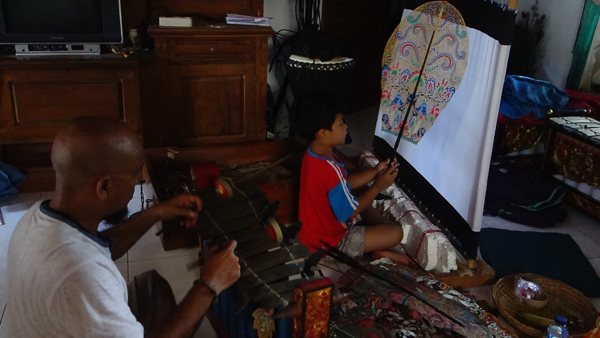
A more basic aspect of Balinese transmission through performance is built into the art forms themselves. Knowledge is transmitted over time through mechanisms that are intrinsic to the art forms, ensuring the past is permanently linked to the present. For example, the kayon (the tree of life puppet; fig. 9) acts as a conduit between the dalang and the wayang world, complete with its own special vocal timbre. This sacred puppet plays a crucial role in the transmission of thoughts, voice, and actions from the wayang world into the present performance world. Before every wayang begins, the dalang holds the kayon, a large, leaf-shaped puppet carved with symbolic iconography representing, among other things, the panca maha bhuta (five powerful elements of earth, water, fire, air, and space) in front of his forehead with the coconut-oil lamp in front of it, silently internalizing the kayonan mantra. At this point he is concentrating on unifying deities into a single powerful entity, one that enables him to access the voices of the puppets. The kayon is used throughout the play as a way to divide acts when the dalang narrates in the voice of Sang Hyang Kawi, the voice of the kayon and the Kawi language (an archaic, literary language linked to Old Javanese in which the noble characters of the wayang speak) with its unique timbre. In addition to being used as a prop, such as wind, waves, or mountains, the kayon frames the entire performance by opening the play with two dances representing the creation and destruction of the universe, and by closing the play when it is planted in the banana log center screen. Similarly, in the first invocation in the wayang (Penyacah Parwa), the dalang acknowledges his teachers and the author of the Mahabharata as a way to link this performance to all that went before it and to make sure the audience is aware of its antecedents (see Zurbuchen 1981:297). A dalang must study the massive body of knowledge, languages, and secret teachings that are used throughout the performance. In this way, wayang embodies and contains the means for its own continuity, serving as a receptacle of knowledge about itself and how it came to be.
As a multimedia, improvisational story-telling genre, traditional wayang is a storehouse of oral and written knowledge. The dalang studies poetic texts in palm-leaf manuscripts (fig. 10 and fig. 11) and quotes from them in performance. To be considered a well-rounded, competent dalang (known as a Kawi Dalang), a performer ostensibly should be so fluent in Kawi that he/she can compose new sentences in it rather than merely memorize fragmented quotations. It is not clear, however, how many dalang today are able to do this. Rote memorization is generally the approach when wayang is taught to children today. The transmission and performance of wayang combine orality with literacy, taking a largely oral approach to the written word (see Sweeney 1987). Other sources include numerous texts of more recent history, such as Babad (Balinese historical chronicles), and contemporary information from world events and the Internet, and of course, local relationships, gossip, and news.
The musical aspects of wayang also contain a great deal of variation and flexibility as the players, with the dalang at the helm, respond to the improvisational nature of the performance. Further, gender performance lends itself to nuanced variation each time a piece is played (see Gray 2011). While gender pieces become more or less fixed within a given style, much stylistic variation occurs from player to player, as they are given the freedom to embellish and alter the tempo, insert moments of rubato, and so forth. Players expect to have this freedom when playing, and they feel it brings the pieces of music to life (I Ketut Buda Astra and many others, personal communication, 2015).
During fieldwork in the 1980s and 1990s, I repeatedly encountered large bodies of musical materials that were no longer in use or were played only in fragmented form. These include swaths of repertoire that have been dropped, such as individual character pieces used for movement (part of the angkat-angkatan category) that formerly contained three developed movements, or sections, with the larger, slower central movement (pangawak) accompanying a dance for each particular character. What remains of these are a handful of generic pieces, only played in their fragmented forms for any character. Numerous examples of vocal elements have also been edited out of today’s performances, leaving behind brief fragments and/or disjointed quotations spanning many sources. They nevertheless remained extremely important to my older teachers, who continued to transmit and fill in knowledge of the fragmented versions of pieces and scenes. My teachers thus served as bridges between practices in the early and late twentieth century. Invariably, in the course of a lesson or an interview, their eyes would mist over as they smoothly segued from current practice to the way things used to be back in “zaman dulu.” Exactly when this earlier era began or ended depended on the performer. They were not simply indulging in nostalgia for “the good old days.” They were conflating past and present while activating a mental mapping from an earlier era as a frame of reference that “completed” the performance experience and allowed for a nuanced interpretation. In the face of recent innovations, many wayang performers fear that the very idea of nuance is slipping away.30
While wayang and its practitioners are still highly revered, and certainly young performers experience some kind of multidimensional mental mapping,31 I have noticed stark differences between the concerns of my teachers and those of current performers who, while being just as intent on perpetuating Bali’s performing arts, are chiefly looking forward by concentrating their efforts on training children’s groups and creating innovative performances to attract younger audiences.
The process has shifted from transmitting the intimate, secret teachings of the dalang or gender master to an individual, to providing large-scale training to children in the hopes they will become performers. This seems to affect the very notion of the performance. Drastic changes in performance venues and audience demands severely limit opportunities to perform “traditional” Balinese wayang. At the same time, these changes also open up a multitude of new possibilities for well-established performers and for a new generation of players and audiences who otherwise might not be drawn to wayang and gender wayang. It is clear that the transmission methods are closely related to the content of what is transmitted: reaching large numbers of students en masse is different from individuals seeking out secret teachings. Instructing so many at once made it necessary to water down and simplify the material. Transmission methodology and numbers of students are closely linked with performance objectives and opportunities: modern, flashy shows that reach large audiences are precisely what young performers wish to study. Many of the older performers, such as Wija, Subandi, Juanda, and Nartha, see this as being economically motivated, with content and depth sacrificed for commercial gain.
Gender, Competitions, and Gender
An important moment in the trajectory of gamelan, wayang, and gender wayang was the introduction of women dalang and gender players around 1980 (see Gold 1998 and Gold 2013).32 That led to the establishment of the categories of female gamelan and wayang at the annual Bali Arts Festival. In large part these women were born into families of performers. The situation today differs greatly in that many little girls now have access to performance roles that were previously restricted to boys.
The recent explosion of privately run arts organizations (sanggar) is having a huge impact on the ecology of Balinese performance and fosters both traditional and innovative values. Prior to the existence of sanggars, a select number of youth had the opportunity to study at the government-run academies, which were constrained by official government mandates to create, perform, tour, and standardize the repertoire on the one hand and by local banjar (community organization) groups that did not necessarily uphold the same artistic standards. Sanggar allowed independent artistic vision on a smaller scale that could support traditional and modern values, and they also contribute to the community by playing in ceremonies and contemporary concerts alike. For many, transmission of the arts from elderly performers to today’s youth is a primary goal. Cutting-edge composition occurs side by side with heightened observance of “tradition” (adat) and value of what is wayah, a term that conveys the sense of something being old, revered, treasured, mature, and of substance. For some, the goal of teaching music and other forms of performance is to give children an entry into Balinese society, with its positive affect on otherwise at-risk youth (Ida Bagus Made Widnayana, personal communication, September 2010). As Sonja Downing has shown, sanggar have given children agency and reformulated gender concepts (Downing 2008:371).33
While the category of dalang cenik (or celik, young dalangs) existed since around 1951, and wayang festivals of child performers have been in place since the 1970s, they were until recently more or less restricted to members of wayang performer families. Training children has become a major focus for the current generation of performers. Ni Ketut Suryatini, the daughter of Konolan, runs a gender wayang sanggar in Denpasar. Sixty young children learn to play gender wayang in groups of fourteen players at once. (The girls’ groups are known as Gangsa Dewa, “[instruments] Music of the Gods.”) She and her brother, I Nyoman Sudarna, have contributed to creating gender wayang competitions, started in 2005 by I Ketut Suandita, for children in Denpasar as part of the twenty-first Pekan Seni Remaja (PSR, Youth Art Week; see Mashino 2009). These competitions forge a link between musical studies and other aspects of the children’s lives. Success increases their chances of being admitted into a good school (Ni Ketut Suryatini, personal communication, July 2011), for example. Suryatini states that she incorporates physical movement and gestures into their playing, and rather than being seen as ritual performance, they are influenced by kebyar (Ni Ketut Suryatini, personal communication, July 2011).
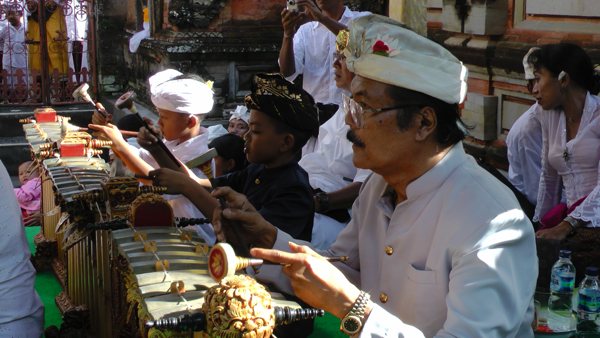
Mashino notes that this exaggerated penampilan (presentation) “might be interpreted as the result of ‘development’ and ‘modernization,’ which are promoted in the agenda of cultural policy,”34 while some judges of the competition felt penampilan is not fitting for gender wayang performance with its sacred associations (Mashino 2009:125). I Wayan Suweca, his daughter Ni Putu Hartini, and his son I Komang Harayana also teach the Kayu Mas style to young children, many of whom are girls (fig. 12). Many similar sanggar have been established, thus opening the study of gender wayang, which was once feared to be too difficult for even the most capable of adult (male) musicians to attempt because of its technical challenges. In addition, as an instrument it represents sophisticated focus (similar to piano lessons in the West), prosperity, and even financial compensation. This is partly due to Bali’s rising middle class. Parents are able to purchase a set of instruments for their children and to pay for lessons. It is also attributable to an increased awareness of the instrument and to the fact that a duo or quartet completes the ensemble, as opposed to larger gamelan. Initially, the PSR competition required pieces to be simplified versions that could be made accessible to newer players. Suweca even produced a set of CDs of slower versions of pieces that could be used for learning purposes, and he has combined various regional stylistic versions into accessible works that he teaches to his students. With other districts of Bali entering students in the festivals, however, the competition has increased. What I observed in Sukawati in 2015 were not simplified versions at all but rather performances of adult-standard proficiency.
Gender wayang competitions have also brought the ensemble into the limelight. The most frequent appearance of the ensemble in Bali is in ritual and wayang accompaniment. As Mashino points out, in these situations the focus is rarely on the musicians’ performance but rather on the rituals and the drama (Mashino 2009:113). Referring to my earlier work, she also notes that this shift in focus to gender wayang harkens to an earlier era (my teachers’ zaman dulu), when a gender wayang performance occurred before the wayang began (Konolan, Loceng, and others, personal communication, 1981–1990s).
One of the more significant aspects to the children’s competitions, and to children playing gender wayang in general, is that girl gender players often take a leading role—and there is no question of their competence level, unlike the larger mixed gender or female ensembles that are considered inferior to their male counterparts (Mashino 2009). This could, in part, be due to the chamber nature of the ensemble, where the competence level of the player is on display and readily perceived. With access no longer being denied to learning the instrument, girls are able to approach it without the built-in prejudices their teachers might associate with girls participating in the larger ensembles. As each girl succeeds in mastering the instrument, it inspires others to follow suit, and teachers are encouraged to push them with difficult material. The perception that girls are weak and therefore are unable to reach the same degree of proficiency, however, still remains with certain teachers (e.g., Suweca). Others do not have such prejudices (e.g., I Made Subandi and I Ketut Buda Astra). Gender wayang players, in general, seem to be evaluated on their own terms, transcending gender differences.
One sanggar significantly affecting the transmission of gender wayang is led by I Ketut Buda Astra in Banjar Babakan, Sukawati. He trains dozens of young children in gender wayang at his home studio, Sanggar Swara Murti (“The sound of an embodied divine spirit”). Buda feels passionately that it should be open to any and all children who have the enthusiasm and discipline to overcome the technical challenges of the instrument and the complexity of the music. Contrary to the way he himself learned and to secretive and exclusionary teachings of Loceng and other players, Buda is on a mission to promote gender wayang. (He describes himself as a gender fanatik.) Casting a wide net, he has visited numerous young students throughout his district of Gianyar in search of new sanggar members. As part of the government committee for the arts in Gianyar, he has also been involved in the government-run island-wide competitions. In 2013 his thirteen-year-old daughter won first prize in gender wayang at the PKB (Pesta Kesenian Bali, annual Bali Arts Festival), and the next year she participated in the dalang competition there.
I listened to the quartet he was training in 2014 for the PKB. The girls in the group, ranging in age from nine to eleven, won first prize. They played with phenomenal spirit, technical virtuosity, tight coordination, and with big smiles on their faces (fig. 13, fig. 14, fig. 15, fig. 16, fig. 17).35 Buda explained that he feels children in elementary and middle school have the best hope of success because they are not yet hampered by the time constraints that older kids and adults have. He attributes the fact that his competing group is made up of girls in a mixed gender category to the girls’ ability to focus on technique, their openness to direction, and their strength as players. He stresses their agem (a term used in dance for a basic stance that defines a character) and other physical aspects that he states are not like kebyar gaya (unlike Suryatini’s training of kids) but are particular to gender and to instilling confidence and unity among the players.36
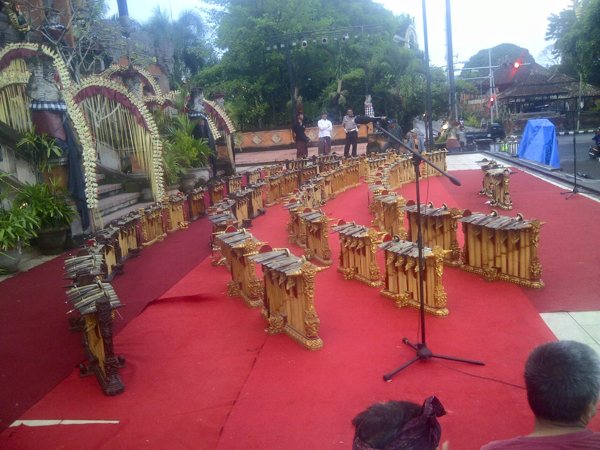
For the anniversary of the city of Gianyar. Buda created an ensemble of fifty children playing gender wayang simultaneously (fig. 18). He does not feel such massive arrangements defeat the purpose of intimate individualistic playing that is intrinsic to gender wayang because in this case he thinks it is more important to demonstrate the sheer number of young people playing gender now. Obviously a group of this size requires a different kind of pedagogy, and the end result is much more standardized and less nuanced—but Buda’s end goal is for at least some of these children to become serious players.
Cumulative Performance Contexts and Genres
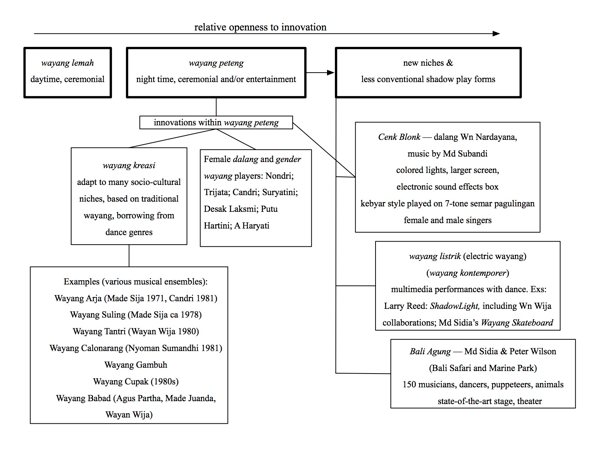
The transmission systems discussed here support innovations as well as longstanding traditions. Each new performance genre takes elements from previous ones, and new performance contexts emerge. Built into the dynamic set of relationships in the ecosystem of Balinese performing arts are contextual and subgenre niches in which people expect relative stability in performance practices and niches where innovation is not only possible but also expected (fig. 19). Wayang can be seen as a continuum from sacred to less sacred, from daytime, ceremonial wayang performed for gods to nighttime entertainment for human audiences. Since I discuss some of these processes elsewhere (Gold 2013, I list examples of innovators and innovations here. That these niches have accumulated rather than superceding one another is remarkable, not a given. It is further evidence that Balinese performers and audiences value both innovation and the continuation of older practices that fulfill religious needs.
I Wayan Wija, who created the Wayang Tantri in 1980, has made many complete sets of innovative puppets, such as female comic servant puppets with articulated torsos, dinosaurs, birds with flapping wings, and other animals (fig. 20 and fig. 21). Formerly a dance drama genre from the 1930s, Wayang Tantri is based on animal tales from India that Wija adapted to wayang. Wayan Loceng created the original musical accompaniment, using four gender rambat (pelog-tuned genders), drums, percussion, gong, and suling. Subandi later added to this repertoire and became Wija’s leading musician for this genre (see Gold 2013). I have seen puppet designs and entire scenes lifted from Wija’s work by other dalang, but as Wija states, it is not enough to copy the design of a puppet. You must menjiwai the character (give it soul or spirit to make it come to life), which few can do (Wija, personal communication, April 2015). Following a process developed by Larry Reed, a dalang based in San Francisco, Wija created puppets on bendable mirrors. When bent, the puppets appear ethereal as spirits, and they have the ability to walk off the screen and onto a nearby wall or ceiling (fig. 22 and fig. 23).
Among the “innovations within wayang peteng,” night wayang shows newer genres that are modeled on older ones. They use the same piece categories as well as similar dramatic conventions and character types, such as the all-important kayon (tree of life) and two pairs of servant translators. New content is inserted through ensemble types, musical pieces, dramatic scenes, characters, and puppets. Like traditional wayang, these are improvisatory performances in standard contexts, with a great deal of personal interaction between the dalang, the host, and the audience. For such reasons, these wayang occupy a niche similar to traditional wayang and are considered acceptable to be performed in long-familiar contexts.
In a different niche are new works that diverge from these conventions and are highly scripted, without the interactions among dalang, host, and audience that are so crucial to traditional Balinese performing arts. The most popular recent form, Wayang Cenkblonk (pronounced Cengblong), was created around 2004 by I Wayan Nardayana from Belayu Tabanan.37 It uses an extra-wide screen, colored laser lights, and smoke machines, a seven-tone semar pagulingan playing kebyar-like music created by the innovative composer I Made Subandi, and a female and male chorus influenced by Javanese vocal music created by Ni Desak Made Suarti Laksmi, a prominent female musician, composer, and singer. This form has had a huge impact on wayang performance, drawing crowds of five thousand ticket-buying spectators to giant venues and generating Facebook fan pages and blogs. Though Cenkblonk is flashy and uses contemporary themes to appeal to younger audiences, much of it fits the matrix of traditional wayang even as it pushes the envelope.
Further out on the contemporary spectrum, Wayang Listrik (electric wayang) is influenced by American dalang Larry Reed and his company, ShadowLight Productions. Reed has developed new projection techniques that use multiple light sources and a giant screen with dancers. His collaborations with Balinese musicians, including Wija, inspired the hugely popular Wayang Listrik by dalang I Made Sidia.
Sidia created his form of Wayang Listrik (nicknamed Wayang Skateboard) in response to the 2002 Bali suicide bombings.38 He continues to develop it for other sociopolitical themes by drawing on traditional sources. His wayang uses computer projections, strobe lights, halogen and colored lights, gels with scenery, and dancers wearing headdresses that create silhouettes on a giant movie-size screen. Young puppeteers roll around on skateboard-like dollies and move in a complex choreography to manipulate multiple puppets, including traditional rawhide and large, contemporary, neoprene figures. As in most wayang, one single person narrates and voices all characters (fig. 24, fig. 25, fig. 26, fig. 27). The music, initially composed by I Made Subandi, is similar to the Cenkblonk ensemble, with the addition of a rock band (drum kit, electric bass, and electric guitar) playing a combination of kebyar-like music with sudden modulations and underlying rock chord changes. Since the first incarnation of Wayang Listrik, Sidia’s own sanggar musicians have created original accompaniment that is closely based on Subandi’s, but they have added sound effects, a synthesizer, and prerecorded rock music, which is only occasionally used.
Sanggar Paripurna, Sidia’s sanggar in his village of Bona, Gianyar, is always bursting with youthful activity and excitement as he directs his latest creations. It has grown in number to include some six hundred musicians, dancers, and shadow puppeteers. Many of them are in their teens and twenties, and some projects include children. Since several of these young people come from families of performers, they bring a high level of competence to his endeavors. While some Wayang Listrik only involve twenty to thirty performers, other projects are produced on a much larger scale. In 2015 I witnessed a Wayang Listrik performance with Sidia narrating as dalang while ten to fifteen young puppeteers performed with dancers and a full gamelan. After that performance, Sidia told me he had another Wayang Listrik troupe from his sanggar performing at a different venue. His work is competently self-replicating even without his presence.
Video 3. Wayang Listrik by I Made Sidia, Sanggar Paripurna. Example of the character Bima first portrayed by a shadow puppet and then by a dancer against film projections of fire as Bima finds powerful stones. Recorded in Rangki by Lisa Gold and Ben Brinner, 2015; used with permission.
Video 4. Wayang Listrik by I Made Sidia, Sanggar Paripurna. Example of multiple dancers as Siwa, leading into the opening kayon (tree of life) dance against film projections. Recorded in Rangki by Lisa Gold and Ben Brinner, 2015; used with permission.
Sidia has reached a stature in which his projects are well funded. This enables him to realize his vision of extremely large-scale performances. During the summer of 2015, I attended a production celebrating the anniversary of the city of Gianyar. It involved four hundred dancers and musicians; another hundred people were behind the scenes and working the elaborate scenery in nonstop action.39 Wayang has a place even in these large productions. This dance drama included numerous dancers with giant kayon (tree of life) puppets (fig. 28). At a crucial point in the story, the spirit of a deceased character is transformed to a wayang projection on a huge white cloth that suddenly appears, held up by dancers. Four composers contributed to the musical accompaniment, including Gusti Sudarta and I Made Subandi.

Another project that Sidia codirected is a more extreme example of change involving wayang. Bali Agung, recently instituted at the Bali Safari Park, involves a cast of 150 dancers and musicians, giant three-dimensional puppets, and live animals: elephants, tigers, birds of prey, ducks, and a python. Performances are repeated day after day without improvisation.40
The whole experience differs so drastically from Balinese wayang that it is perhaps unfair to consider it within the same genre. Admittedly, a traditional wayang performance frames the entire show, which opens with a giant kayon dance that reinforces the importance of wayang both in Balinese culture and to Sidia himself. However, other than pieces composed and arranged by Subandi and played on a semar pagulingan before the show, gamelan and specifically gender wayang are strikingly absent from the performance.
Seasoned performers debate the value of these newer forms of wayang. Many, such as Wija, Juwanda, Nartha, and others, feel depth and philosophy have been sacrificed. They see modern wayang as a watered-down version of traditional wayang. Some critics of the forms admit they enjoy watching wayang and concede some of the newer innovations have artistic merit. Most performers with whom I spoke agree with the positive aspects of these performances in attracting younger audiences and wayang students. The question remains, however: Will enough young students be drawn to traditional forms to ensure the continuation of this rich body of knowledge before it is lost?
Conclusion
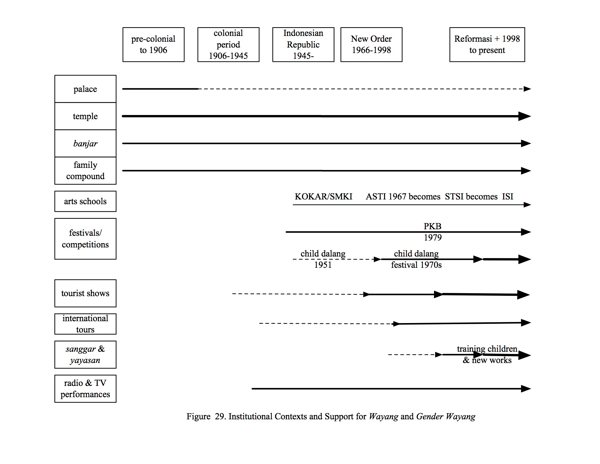
A number of ecological issues can be identified in these examples. Support for the arts, performance contexts, and means of transmission have expanded as new institutions have emerged, providing additional channels for performance and creation (fig. 29). Courts, temples, and village-based neighborhood organizations provide traditional niches that ensure perpetuation of the arts as central elements in numerous ceremonies. Over the past half-century, cultural tourism has developed to massive proportions, affecting repertoire and introducing the economic element of playing for money. Concurrently, government-run arts schools expose students to diverse influences, a standardized repertoire, and a mandate to innovate. Sanggars have freed artists from the constraints of the academy.
Physical spaces for performance have multiplied, and now all sizes of spaces are used. At one end are the small, temporary stage areas delineated in the courtyards of temples (as in traditional wayang and dance), which promote audience involvement. At the other end are impersonal proscenium stages and stadium theaters, as in Bali Agung, Ramayana Kolossal Fragmentari, and sometimes Cenkblonk, but the opposite trends occasionally occur where performers find intimate performance spaces.
Ecologically, some motivations for change include the creative impulse, competition, the need for survival, and the desire to draw youth to traditional arts. Innovations such as Wayang Listrik and Cenkblonk have affected the wayang ecosystem by causing a drastic decline in demand for more traditional wayang and by spurring other dalang to innovate in order to compete for performances. Dalang who perform only traditional wayang, even those who used to perform almost every night of the month, are being hired less frequently. People only want to sponsor groups that put on large spectacles. At the same time, innovators contribute to wayang’s sustainability by attracting younger audiences and performers. On recent visits to Bali I found that all of my major contacts were involved in training children, not just in wayang but also in gender and other types of gamelan and dance. Belief that some children are reincarnations of artistic ancestors helps to fuel this encouragement and explains a kind of innate transmission.
The ecology of Balinese performing arts is becoming more complex as new niches are created that do not compete directly with old ones. In this sense it differs from an ecosystem in the natural world, where one supercedes another. This is not always the case, however, as seen with the spreading of one style of Merak Ngelo and other Kayu Mas pieces or the increasing demand for electric and modern shows and the falling demand for traditional performances.
As the Balinese ecosystem becomes evermore entangled with a globalized world, performers and audiences have come to imagine and expect innovative responses. The proliferation of niches is thus to some extent a reaction to outside factors. In the 1980s and 1990s, performers felt audience pressure to truncate shows because of the competing forces of the fast-paced drama in television and films—or so they thought. Now in the twenty-first century, the stakes are higher and the competition fiercer due to the sensory overload of the Internet, Facebook, mobile phones, video games, and films. Rather than being victims of these influences, performers can be seen as active agents of the change and creativity that have always been at the core of Balinese tradition. They are inspired both by new media and techniques and by the need to compete. New niches do not simply supercede older ones; they are created and exist alongside longstanding categories of performances that fulfill essential functions and do valued cultural work.
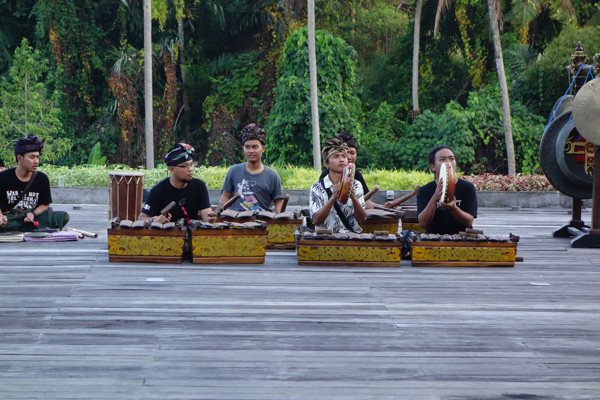
Transmission is deeply personal in Bali. In 2014 I was in the middle of a heated debate between dalang I Wayan Wija, who asserted children learning to be dalang need to be free to experiment and create their own stories, and the musician Subandi, who maintained they need a more formal training of traditional wayang first. Both performers play significant roles in transmission today. (Much as Granyam and Loceng were in their times, Subandi is a major hub who is involved in almost every major project to train musicians throughout Bali [fig. 30].)41 Each teacher with whom I met speaks passionately about this subject. Teachers feel a lifelong sense of responsibility toward their students and vice versa.
Transmission enacts both change and continuity, whether through family members, deceased ancestors teaching through the younger generation, or people who traverse great distances to seek out teachers from afar, as did Sumandhi’s grandfather in Tunjuk when he traveled on horseback across Bali, or when students from the United States, Japan, Europe, Australia, and beyond make their way to Bali, and when teachers from Bali make their way to them. Change and continuity are central to Balinese performance, and they likely always have been. Without innovation, performances are not considered to be alive. Wayang performance has many built-in safeguards for its own regeneration, as long as wayang and gender continue to be performed and the nuanced teachings are passed down. Today’s performers recognize the need to be proactive as guardians of these teachings.
Notes
- 1. Earlier generations of teachers, with whom I worked from 1981 through the 1990s, had these concerns. Here I refer to more recent trips in 2009, 2011, 2014, and 2015.
- 2. A shorter form of this paper was delivered at the International Seminar and Festival of Indonesian Music, held at the Smithsonian Institution in Washington, D.C., from October 31 to November 3, 2013. This essay also encapsulates ideas I have put forth elsewhere (see Gold 1998 and Gold 2013) that are germane to this topic. Since 1981 I have worked closely with several older performers, many of whom are now deceased. How the concept of zaman dulu permeated their performance experience, among other topics, is further developed in these publications and in my forthcoming book.
- 3. Richard Wallis translates Tri Sandhya as “The Threefold Expression of Faith” (Wallis 1980:106). Wallis presents a detailed analysis of the Balinese usage of Sanskrit by Brahman priests as a way of communicating directly with the Indian gods. They utilize sacred syllables to access and reverberate through parts of the body, as each tone is linked to Hindu cosmology. This action was formerly restricted to the Brahman priests, but recently the Trisandya has spread to the wider public through the mandate of the government religious organization Parisada Hindu Dharma Indonesia (Nyoman Sumandhi, personal communication, May 2015).
- 4. This was the case when I conducted fieldwork in 1992–93, and it continues today. The Trisandya invocation is aired at 6 am, 12 noon, and 6 pm. In 1992 I was told that it was sung during the SandiKala, those times of day (noon, dusk, and midnight) when people are particularly vulnerable to evil spirits. Certain precautions are necessary, such as reciting this invocation, which combines Sanskrit mantras from the Vedas and other sacred texts. Wallis explains, “The deep reverberations set in motion by a vocalist are physical (acoustic) counterparts to the metaphysical resonance and harmony of the cosmos implied in the symbol ONG” (Wallis 1980:110). By beginning with “Ong [om], bhur, bhuwah, swah” (earth, sky, and heavens), “in any prayer or formula is a concise way to put oneself in contact with the entire physical universe. Preceding this invocation with the magic syllable ONG [om], however, immediately links together the physical/material with the immaterial which is the Supreme Being” (Wallis 1980:109–11).
- 5. The Trisandya consists of six stanzas from various texts compiled from other rituals, beginning with the Brahma Gayatri, which originated in the Rig Veda and was adapted in the Balinese Caturweda. Wallis provides this translation: “We meditate on that desirable light of God Savitar, Who may promote our inspirations,” and ends with “Forgive the sins of the flesh, Forgive the sins of the mouth, Forgive the sins of the mind, Forgive all these, my sins of negligence. Ong, peace, peace, peace, Ong” (Wallis 1980:112–14). I refer here only to the Indonesian subtitles broadcast by TVRI.
- 6. During an odalan in the village of Tunjuk, Tabanan, in the summer of 2014, I experienced the entire congregation singing the Trisandya together without any accompaniment. It was pouring rain, and everyone sat crowded together in the few pavilions that had roofs. I sat with the gender wayang players, and after the invocation we resumed playing. It was the high point of my trip that year, as the unity of the congregation was affirmed through the long intoned syllables of the invocation.
- 7. The addition of gender wayang accompaniment to this sacred mantra was in itself an innovation of Konolan’s. The piece, whose title Merak Ngelo means “Peacock Spreading its Tail Feathers,” has no dramatic significance in the shadow theater. It is a purely instrumental composition, more typically performed before the play begins. It is now frequently played during the singing of Kakawin (sacred poetry in the Kawi language) and in other sacred rituals.
- 8. I interviewed Lotring’s grandson, Wayan Kelo, who lived in Kuta and was a professional musician. Although he did not often play gender after 1992–93, Kelo still remembered many interesting things about his grandfather’s usage of pieces in ritual and wayang.
- 9. Loceng used this same gineman for other pieces, such as Sekar Sungsang, Cangak Mrengang, and Seketi. According to Konolan, this gineman was composed in the 1970s by Ida Bagus Deksa, who at the time of the interview in 1992 was a pendeta (priest) in the village of Blakiyu.
- 10. This is the polar opposite to my Tunjuk experience, in which the entire village was given agency by singing the Trisandya. Rather than simply listening to the invocation on television being blasted out on neighborhood loudspeakers, the congregation sang it themselves, allowing the vibrations to reverberate within their bodies as intended. The effect of this was palpable. A performance of the gamelan semar pagulingan piece Lengker Cenik is also broadcast during the Trisandya on public loudspeakers. This piece has acquired sacred significance as a result (Wayan Suweca, personal communication, November 2015).
- 11. The Balinese concept of Desa, Kala, Patra (roughly, “appropriate place, time, circumstance”), also known as the Tri Pramana, means that for every activity there is a proper time and place. Place has to do with the natural surroundings and meanings ascribed to spatial orientation; time takes into account numerous overlapping calendars and times of day in relation to the community or to personal lives. This is part of an expanded project informed by work on place and space by Steven Feld and Keith Basso (Feld and Basso 1996), among others.
- 12. Many pieces have a conceptual gong framework despite the lack of a gong. Several of these are free of the binary gong structures imposed on pieces in the larger types of gamelan and have asymmetrical structures. The gender wayang repertoire, however, has absorbed elements of other ensembles, such as gamelan angklung and gong kebyar, as it has also provided source material for pieces in those ensembles.
- 13. Nick Gray discusses what he calls “improvisation” in gender wayang (Gray 2011). While I don’t necessarily agree with the usage of the term, I do agree with his analyses of the flexibility of the repertoire.
- 14. This is part of a larger ongoing project with Ben Brinner.
- 15. In his paper “Towards an Ecology of Musical Practice” given at UC Berkeley on February 10, 2010, Tony Seeger notes the differences between ecology in nature, such as the study of frogs in a Vermont pond, and the constantly changing musical world, which has the agency of people making music (Seeger 2010). He examines change, loss, and displacement that in some cases lead to the inception of other forms and instruments. In his contribution to the UNESCO project “Masterpieces of the Oral and Intangible Heritage of Humanity,” he delineated a list of fifty-nine reasons for change and loss. Bali would have its own set of criteria and its own complex system.
- 16. For instance, I Gusti Nyoman Darta (a.k.a. I Gusti Komin) and his brother, I Gusti Ketut Muliawan, two of the most phenomenal gender wayang players in Bali today, have developed their own style, based on the style from their village of Pengosekan. Their style also has a heavy influence from Sukawati because of various transmission paths.
- 17. Double damping is what I call clicking the damped note with the panggul (mallets). Loceng would add these in his rapid interlocking patterns to delay the sounded note, accentuating a syncopation while assuring the rapid interlocking was maintained at a regular rate.
- 18. Their adult sons are known dalang and gender players: I Wayan Mardika, I Komang Aryawan, and I Kadek Budi Setiawan. Also of note is gender wayang player I Komang Wraspatika, among many other talented young players.
- 19. Granyam’s son, I Wayan Wiji (a.k.a. Ganjering), and four of Ganjering’s five children, including one female (Ni Kadek Suci), followed in Granyam’s lineage as Sukawati dalang, and now his great-granddaughter, Kadek Istya Devi, is an accomplished gender player at age eleven.
- 20. Granyam was one of four prominent Sukawati dalang from his generation to whom younger players often refer. These were Granyam’s older brother I Wayan Gayung, I Nyoman Granyam, I Wayan Cetug (Granyam’s cousin of the same age), and I Made Rawa, Granyam’s nephew. Influencing both Granyam and Loceng was I Wayan Lotring (circa 1898–1983), a renowned composer from Kuta who taught in many places, cross-pollinating local traditions (see Gold 1998 and Gold 2013).
- 21. Additionally, Ni Ketut Trijata was one of the four female dalang in Bali beginning in the 1980s. She still occasionally performs ceremonial wayang in Tunjuk.
- 22. Sumandhi, my first Balinese teacher at the Center for World Music in 1974, studied and taught in the United States. (He received his BA at UCLA and his MA at Wesleyan in 1979, both in ethnomusicology.) He was director of the Bali government arts conservatory SMKI (Sekolah Menengah Karawitan Indonesia).
- 23. Larry Reed’s excellent film Shadowmaster (Reed 1981) shows most of these performers in wayang performance.
- 24. Today the distance between Sukawati and Tunjuk is only around two hours by car, and people are used to traveling great distances. In decades past, before there were decent roads, people tended not to travel outside of their area. That led to an insularity of styles. Edward Herbst described early kebyar composers in the 1920s walking for two weeks in order to transmit music across Bali. These rare and arduous journeys had a significant impact on the development and transmission of musical ideas (Herbst colloquium, UC Berkeley, April 2012). Heimarck describes wayang performers walking, wading sometimes neck deep across rivers, and even swimming to some performances. Such stories illustrate the scarcity of transportation and the musicians’ sheer motivation to reach performance sites (Heimarck 2003:60).
- 25. Musicians from disparate areas love to trade versions and piece together complex historical connections. Of course, each one likes to believe he has the earlier versions, and some are unwilling to share their own versions.
- 26. In other genres, such as gamelan gong, or in sacred ensembles, such as gamelan gambang, a Balinese solfege notation system of symbols representing vowel sounds can be used to store the pokok, or main skeletal pitches, in a piece. Composers frequently write down their musical ideas by using this system when composing or teaching new material to a group, and numerous classical compositions are stored in this manner. Musicians, however, never refer to this notation during performance, and it is never used in gender wayang. This could also be because no single instrument plays the pokok in gender wayang. Instead, each instrument plays complex two-handed contrapuntal textures that would be cumbersome to notate using this system. It is interesting to see the recent use of mobile phones during rehearsals of some complex contemporary pieces. Musicians in composer Dewa Ketut Alit’s contemporary Gamelan Salukat refer to their mobile phones during rehearsal for their notes on the sequence of musical phrases that are too new, complex, or unlike traditional gamelan to rely on older methods of rote learning. Yet, in the latter case, it is just a new form of mnemonic device, distinct from musical notation, that players have not adopted.
- 27. In traditional wayang, each dalang has two assistants handing him puppets, repairing them when they break, and maintaining the coconut-oil lamp throughout the performance. In modern wayang the number may vary, such as Cenkblonk in which there are five assistants, one whose main job is to massage and wipe down the sweat from the dalang throughout the performance.
- 28. Buda’s older brother, the dalang Made Juanda, was born into a wayang family in 1964 and was surrounded by wayang performance from an early age. Juanda has a childhood memory of the great dalang I Wayan Wija practicing in his home. At that time Juanda assisted both Wija and the great Ketut Madra. Juanda was selected by Madra to perform in Jakarta in 1978 in a search for young dalang (dalang celik). He believes he was chosen because as an assistant he followed the stories closely. In his training, rather than absorbing wayang gradually, Juanda was forced to study all aspects at once—story, kakawin poetry, and puppet manipulation—in time for the performance. The story most often chosen for testing Sukawati dalang is from the Bharatayuddha, which is considered especially heavy and difficult since it contains much of the necessary materials to be mastered. Juanda tells of the performance being held in a light drizzle (grimis), which is auspicious for a debut performance, granting taksu (divine inspiration) or other wishes requested by the young performer. Once chosen, he felt an immense responsibility to the wayang kulit tradition.
- 29. I lived in Bali for thirteen months in 1981 and 1982, studying gender wayang in all three areas mentioned here. At that time Loceng had only taught a few foreign students, including Andrew Toth and Christina Melcher, before me. His teaching methodology consisted of playing the entire piece at full tempo until I gradually made sense of it myself. A lesson would last all day, from morning until night, with playing interspersed with many discussions and Loceng imparting philosophy, gossip, and wayang stories. As the years passed, he gained numerous students, many from Japan and Europe. He also shortened his lesson time and changed his teaching methodology drastically by breaking down parts and teaching them slowly. Other teachers, such as Konolan and Suweca, were already doing this.
- 30. While this was not merely nostalgia, engaging in nostalgic reminiscences is another aspect of mental mapping that is widespread in Bali and is important to consider. McGraw, for instance, cites musicians’ nostalgia for former times when, they believe, group cohesion was more evident and enabled more nuanced tempo fluctuations necessary for ensemble performance (McGraw 2008b:153).
- 31. When I speak of the kind of “mental mapping” that my teachers from earlier generations experienced, I am referring to a conflation of past and present: they had in their minds a filled-in or more complete picture of repertoire, both gender wayang and verbal, and other materials that were no longer in use even in 1981 to some degree. Between 1981 and 1990 much had been lost. According to those teachers, that was just a fraction of what had already been lost since the 1930s and earlier. Yet they managed to fill in the missing information in their minds as they played. This is the way they described it to me during my research. They felt it necessary to pass along to me some of this material so I, too, would understand the fragmented versions of pieces, songs, and scenes that remained. An example was the pangalang (borders) that were used to establish the presence of the entering character in the opening meeting scene of every wayang. Pangalang Ratu (the king’s border) was played and sung before the entrance of a noble lead character (a variety of these were character-specific), while Pangalang Punakawan (the servants’ border) was played before the entrance of Twalen and Merdah, the two comic servants of the dalang’s right side. These used to be full pieces and lyrical songs, but by 1990 only a brief gender wayang fragment remained. The young wayang students who had the benefit of learning from these elderly performers are now in the forefront as the experienced ones. While they remember former practices, in their lifetime they were never able to play them in the way their teachers actually had. Therefore, what they are passing down to new performers—especially children, since that is a major goal at this point in time—tends to be severely truncated and formulaic. I do not wish to imply that they do not experience some form of “mental mapping.” The contents of their “maps” must drastically differ. Furthermore, numerous young performers have never had the benefit of working with or even living during the era of these former performers, so they are passing down wayang in an increasingly truncated form.
- 32. According to Adrian Vickers, there is evidence from lontar (palm-leaf manuscripts, particularly in Smaradahana Kekawin Lontar Prasi in the possession of Anak Agung [Gusti] Putu Jelantik) that women musicians existed in the courts prior to the Dutch period (Vickers 1985b). These lontar depict illustrations of female musicians. While it is not clear whether these included gender wayang, they do show women playing suling (flutes), rebab (a two-string bowed lute), and metallophones.
- 33. With “the potential to radically alter socially accepted ideas about gender . . . the resulting reformulation of gender concepts by members of these gamelan ensembles is indicative of the current complex changes in gender roles in Bali and Indonesia” (Downing 2008:371). Widnayana saw a positive impact on some youths of his community. He feels playing gamelan steered them away from drugs and drinking by bringing them into a positive, communal situation, by exposing them to a disciplined practice of playing music, and by educating them about Balinese culture. Mashino supports this claim, stating, “Although I could not find any supporting documentary evidence, many Balinese told me that the PSR (gender wayangi competition) initially aimed at using the arts to hinder juvenile delinquency. Belief in the efficacy of the performing arts as a defence against the negative allure for youth of alcohol, drugs, and pornography seems to be quite common among the Balinese, especially in the mass media” (Mashino 2009:121). This is in keeping with the Ajeg Bali movement. “The name Ajeg literally means to preserve or strengthen Bali, and the movement is a campaign to maintain ‘Balinese-ness’ in the face of ‘evil’ outside influences, such as the threats of globalization and terrorism” (Schulte Nordholt 2007:55; Mashino 2009:122).
- 34. The sponsor of the PSR competition was the local Balinese government, whose stated theme was “Through Pekan Seni Remaja (PSR) in junior high schools, senior high schools, and technical colleges with art competition in pre-schools and elementary schools in Denpasar, we develop creativity among children and youth, as well as establish the role of Denpasar as a cultural city” (Kriteria Pekan Seni Remaja 2007:1, translated by Mashino). As Mashino observes, this is in keeping with the Indonesian post-Suharto Reformasi policies (Mashino 2009:119–20). She also notes that local organizers of the competition cite kaderisasi (perpetuation of tradition) as its primary goal, while the sponsors wished to promote gender wayang specifically to demonstrate the “cultural prominence of Denpasar and success of [then-governor] Puspayoga’s cultural policy.”
- 35. At age eleven, the leader, Kadek Istya Devi, had all the developed gestures of an adult. She also happens to be the great-great-granddaughter of Granyam. The other members I saw were Komang Ayu Dinda Febrina Putri, age ten, and Wayan Mayeta Hani Pramesuari, age nine. The fourth was absent that day, so Buda’s seven-year-old daughter, Komang Laura Asna Pratiwi, sat in. She is well on her way to reaching the same accomplishments.
- 36. Gaya is a term used to describe the flashy, dance-like physical movements that have become a hallmark of gamelan gong kebyar, the fiery twentieth-century style of playing in large ensembles. The movement promotes group cohesion, but it is also an external display of the energy of the music. In Denpasar teachers, such as Ni Ketut Suryatini and I Nyoman Sudarna, have promoted the use of gender-specific gaya, borrowing ideas from kebyar gaya, such as the players holding their hands palms outward in front of them while shaking or trembling their fingers and then forming arcs with their hands in unison before picking up their mallets. For girls, Suryatini has choreographed specific head and torso movements as well. Buda, on the other hand, disagrees with this practice and thinks it detracts from the seriousness and intent of the music. He has developed his own, more subtle movements (Buda, personal communication, April 2015).
- 37. Pronounced Cengblong, it is named after its two comic servant characters, Nang Klenceng and Pan Eblong (but spelled Cenk Blonk).
- 38. “This performance is aimed at consoling the grieving community, persuading people to cope with the tragedy as a single, unified community, and to motivate them to fight the violence in a healthy, peaceful manner. . . . Sidia prepared a special story to uplift the spirit of the people. It was aptly titled Dasa Nama Kertha (The Ten Names of Peace). . . . DNK was inspired by an episode from the ancient palm manuscript of Siwa Tatwa, illustrating the victory of peace over the brutal violence of the demons” (I Wayan Juniartha, “Wayang Dasa Nama Kerta” Jakarta Post, November 18, 2005). See also Sedana 2005 and Stepputat 2013.
- 39. The scale of these productions seems to increase each year. Earlier that day Nyoman Cerita’s choreography for a thousand dancers was performed on the field in front of the same venue.
- 40. Some of the dancer-puppets are reminiscent of Julie Taymor’s work on The Lion King. Taymor was originally influenced by her work in Balinese traditional theater, so there is a cyclic pattern of cross-cultural influence.
- 41. This includes an inadvertent revival of the old Tunjuk-Sukawati transmission path: Wawan and other young Tunjuk gender players are now sent to study with Subandi.
Next: The Challenges of Music Sustainability in Lombok, Indonesia »


